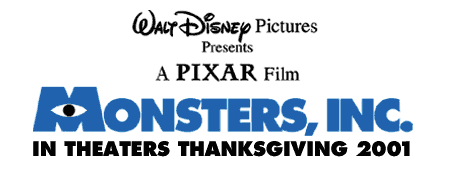
Cast * Story * Interesting Facts * Interviews * Making Of * Deleted Scene

Cast * Story * Interesting Facts * Interviews * Making Of * Deleted Scene
 |
 |
 |
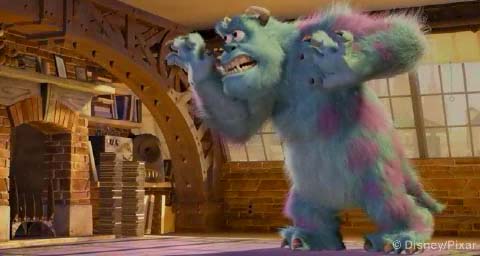 |
 |
Directed by: Pete Docter & David Silverman
Written by: Andrew Stanton & Dan Gerson
Music by: Randy Newman
Production started on: May 4, 1999
Release Date: November 2, 2001
Running Time: 95 minutes
Budget: $100 to $115 million (plus another $50 to $100 million
for prints and advertising)
U.S. Opening Weekend: $62.577 million over 3,237 screens
Box-Office: $255.87 million in the U.S., $524.27 million worldwide
Video Revenue: $384.8 million from DVD and VHS rentals and purchases
(21 million copies were sold)
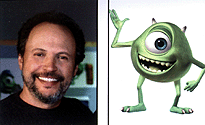 |
 |
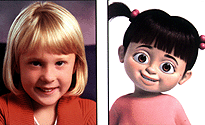 |
Boo... Mary Gibbs
James P. Sullivan... John Goodman
Mike Wzowski... Billy Crystal
Henry J. Waternoose... James Coburn
Celia... Jennifer Tilly
Randall Boggs... Steve Buscemi
Roz... Bob Peterson
and Bonny Hunt
 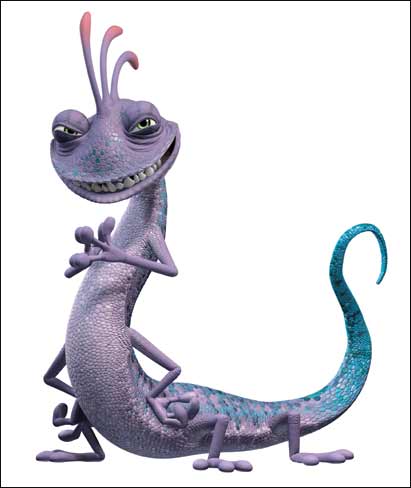 |
 |
 |
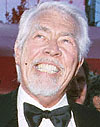 |
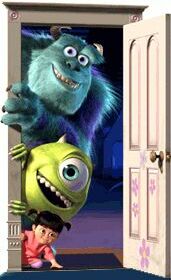 Horrible
creatures live in a parallel dimension right next door to our world.
The key difference between our world and theirs? In the monster's dimension,
they don't use gasoline, oil, or electricity to power their machinery.
They need the screams of small children to keep the wheels of industry
rolling.
Horrible
creatures live in a parallel dimension right next door to our world.
The key difference between our world and theirs? In the monster's dimension,
they don't use gasoline, oil, or electricity to power their machinery.
They need the screams of small children to keep the wheels of industry
rolling.
Monsters, Incorporated is the largest scare factory in the monster world and James P. Sullivan (voiced by John Goodman) is one of its top Scarers. Monsters must audition for a spot and then are transported under the bed and must capture screams. Jim and his close pal, Mike Wzowski (voiced by Billy Crystal, both shown above) sneak into our world every night. They burst out of closets and/or sneak out from under beds. All in an effort to scare some kids so that Jim and Mike can collect their screams and bring this all important energy source back into the monster realm. There is one rule though: Never Bring Back A Child!
Jim is highly thought of in the monster world. His boss, Henry J. Waternoose (voiced by James Coburn) praises him. Mr. Waternoose's secretary, Celia (voiced by Jennifer Tilly) adores him. Jim's on top of the world, at the top of his game ... until he and Mike make one small mistake. One awful night, they accidentally let a 3-year old human girl named Boo (voiced by Mary Gibbs) follow them back through the portal.
Jim and Mile are immediately punished by being exiled to our dimension.
There they find out that the monsters of our urban legends like Bigfoot,
Nessie, and Yeti are also exiled monsters. Eventually, the heroes
realize that not only screams power their homeworld but so does laughter...
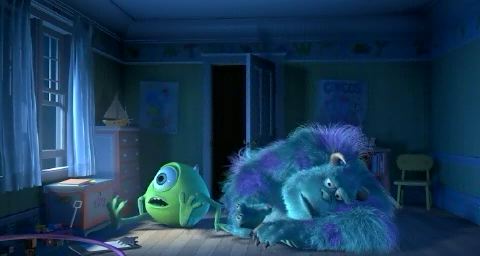 |
 |
 |
 |
![]() Another title
used early in this film's development was The Hidden City -the name
of a restaurant across the street from Pixar's headquarters!
Another title
used early in this film's development was The Hidden City -the name
of a restaurant across the street from Pixar's headquarters!
![]() Monsters, Inc.
was in pre-production for close to two years before it was officially started.
Monsters, Inc.
was in pre-production for close to two years before it was officially started.
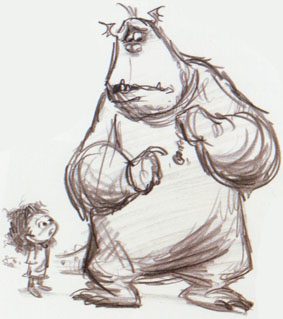
![]() It is taken from
a short movie that producer John Lasseter did in college, called Monsters,
and that won a student Emmy. It was about a little boy who was afraid
to turn off his bedroom lights at night because the shadows would turn
into monsters. So when the lights would go out and the monsters would appear,
he would turn the light back on. Well, he started flicking the light switch
so fast once, that one of the monsters didn't have the chance to disappear,
so it now was stuck in the boy's "real world". In a cute moment, both the
boy AND the monster got scared of each other and both jumped under the
boy's bed covers. After a little time, they both became friends and the
little boy became buddies with all of the monsters in his room.
It is taken from
a short movie that producer John Lasseter did in college, called Monsters,
and that won a student Emmy. It was about a little boy who was afraid
to turn off his bedroom lights at night because the shadows would turn
into monsters. So when the lights would go out and the monsters would appear,
he would turn the light back on. Well, he started flicking the light switch
so fast once, that one of the monsters didn't have the chance to disappear,
so it now was stuck in the boy's "real world". In a cute moment, both the
boy AND the monster got scared of each other and both jumped under the
boy's bed covers. After a little time, they both became friends and the
little boy became buddies with all of the monsters in his room.
![]() Monsters, Inc.
was originally built around a 32-year-old computer programmer whose life
becomes incredibly complicated once his childhood fears and phobias suddenly
become real. For almost a year, this is the story idea that Monsters, Inc.
director Peter Docter seriously tried to turn into a workable screenplay.
The hero of the film was supposed to be a computer programmer who is leading
this incredibly humdrum life. The guy's career and love life were going
nowhere. He's at a dead end, spiritually and emotionally. All seems lost
until the guy's mother (who's in the process of turning his old bedroom
into a guest room) sends the computer programmer a box full of his childhood
belongings. Among the objects in this box is a book of a drawings that
the computer programmer made when he was a kid. "And what are these drawings
of?" you ask. The monsters that our hero used to dream up back when he
was six or seven. As the computer programmer opens up this book, some loose
pages flutter to the floor of his cubicle at work. He thinks nothing of
this... Until the monsters on these pages suddenly spring to life, stepping
out into the real world and begin harassing the poor guy. PeteDocter was
hoping that Pixar could produce a film that would put a post-modern spin
on that old 1950 Universal Pictures / Jimmy Stewart classic, Harvey.
Only the computer programmer can see the monsters that were now bedeviling
him. None of this guy's co-workers are aware of the nightmarish creatures
that are now making this guy's life a living hell. Over time, the film's
story would be revealed that these monsters aren't just any monsters. They
were the actual physical incarnations of the computer programmer's childhood
fears. Phobias that continue to hold this guy back even in his adult life.
And -- as our hero dealt with each of these creatures -- he'd end up confronting
one of his childhood fears. And once he did so ... That monster would disappear.
Monsters, Inc.
was originally built around a 32-year-old computer programmer whose life
becomes incredibly complicated once his childhood fears and phobias suddenly
become real. For almost a year, this is the story idea that Monsters, Inc.
director Peter Docter seriously tried to turn into a workable screenplay.
The hero of the film was supposed to be a computer programmer who is leading
this incredibly humdrum life. The guy's career and love life were going
nowhere. He's at a dead end, spiritually and emotionally. All seems lost
until the guy's mother (who's in the process of turning his old bedroom
into a guest room) sends the computer programmer a box full of his childhood
belongings. Among the objects in this box is a book of a drawings that
the computer programmer made when he was a kid. "And what are these drawings
of?" you ask. The monsters that our hero used to dream up back when he
was six or seven. As the computer programmer opens up this book, some loose
pages flutter to the floor of his cubicle at work. He thinks nothing of
this... Until the monsters on these pages suddenly spring to life, stepping
out into the real world and begin harassing the poor guy. PeteDocter was
hoping that Pixar could produce a film that would put a post-modern spin
on that old 1950 Universal Pictures / Jimmy Stewart classic, Harvey.
Only the computer programmer can see the monsters that were now bedeviling
him. None of this guy's co-workers are aware of the nightmarish creatures
that are now making this guy's life a living hell. Over time, the film's
story would be revealed that these monsters aren't just any monsters. They
were the actual physical incarnations of the computer programmer's childhood
fears. Phobias that continue to hold this guy back even in his adult life.
And -- as our hero dealt with each of these creatures -- he'd end up confronting
one of his childhood fears. And once he did so ... That monster would disappear.
![]() Steve Buscemi's
casting as the voice of one of the monsters was rumored since the project
went in production, in May 1999. All other cast members were only
announced on August 10, 2000.
Steve Buscemi's
casting as the voice of one of the monsters was rumored since the project
went in production, in May 1999. All other cast members were only
announced on August 10, 2000.
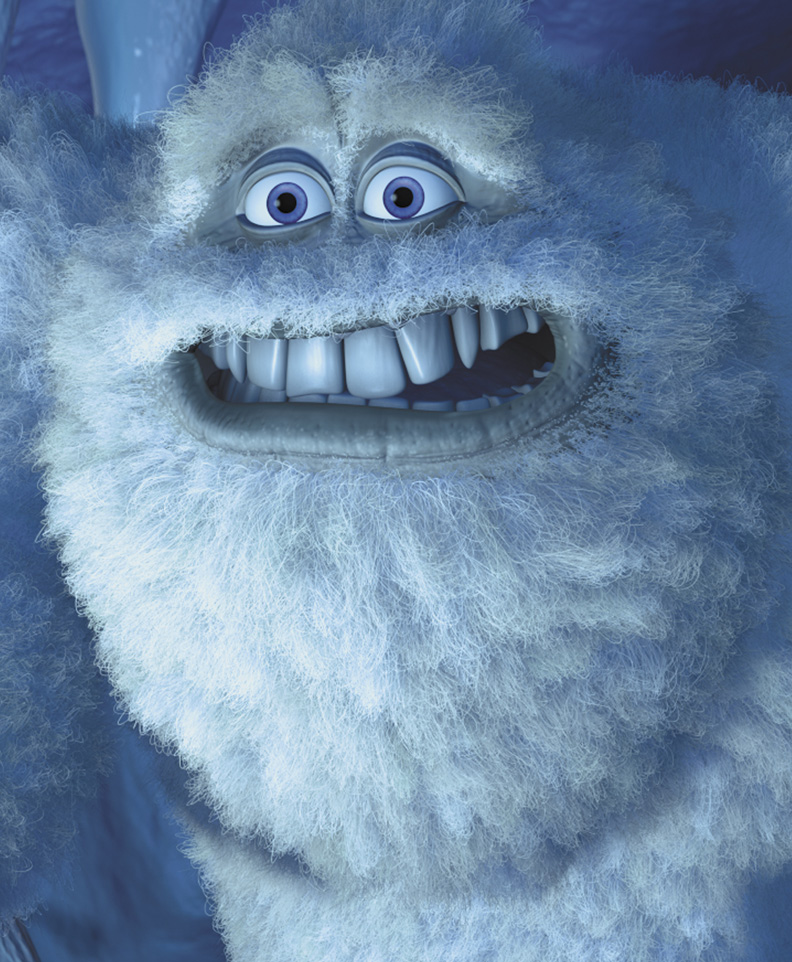
![]() John Ratzenberger
(the Yeti of the Himalayas) is a Pixar regular who previously voiced Hamm
the Piggy Bank in the Toy Story films and Flea in A
Bug's Life.
John Ratzenberger
(the Yeti of the Himalayas) is a Pixar regular who previously voiced Hamm
the Piggy Bank in the Toy Story films and Flea in A
Bug's Life.
![]() "We like to start
with something universal, like in Toy Story
-- all kids imagine their toys can walk and talk," Pete Docter says. "So
we came up with monsters in the closet. All kids think there's a monster
hiding in the closet." John Lasseter is very big on story. "You have
to get the story right," he says. "No computer or animated effects can
save a bad story. We spend a good chunk of time just getting the story
right -- 2, 2 1/2 years. "Animation is too expensive. Essentially, we have
to edit the film in advance of producing it. We first produce a version
using still drawings. We also produce versions of the movie using storyboards."
Once the story is fleshed out, it's time for the actors to start recording
dialogue. "We record them over 12 to 15 sessions of about four hours each
every few months," Pete Docter says. "It's a real challenge, actingwise."
John Lasseter adds: "The thing we always do is match the voice and personality
to the character. We want it to sound natural, so we never ask the actors
to do a character voice. We want it to appeal to us, to the adults in the
audience, too, to make it be a real movie, to find that balance." Because
the scenes haven't been animated at the time of the recording sessions,
the actors are free to ad-lib. "The great thing is that this is relaxed,"
assistant director Lee Unkrich says. "We try to foster an atmosphere where
the actors can be really creative and loose." In deciding what ad-libs
to use and what to discard, the filmmakers try to remember their first
response. "We like things that make us laugh the first time we hear it,"
Lasseter says. "Eventually, we'll hear everything 500,000 times, but if
we remember that first time, we're pretty sure it will make the audience
laugh, too."
"We like to start
with something universal, like in Toy Story
-- all kids imagine their toys can walk and talk," Pete Docter says. "So
we came up with monsters in the closet. All kids think there's a monster
hiding in the closet." John Lasseter is very big on story. "You have
to get the story right," he says. "No computer or animated effects can
save a bad story. We spend a good chunk of time just getting the story
right -- 2, 2 1/2 years. "Animation is too expensive. Essentially, we have
to edit the film in advance of producing it. We first produce a version
using still drawings. We also produce versions of the movie using storyboards."
Once the story is fleshed out, it's time for the actors to start recording
dialogue. "We record them over 12 to 15 sessions of about four hours each
every few months," Pete Docter says. "It's a real challenge, actingwise."
John Lasseter adds: "The thing we always do is match the voice and personality
to the character. We want it to sound natural, so we never ask the actors
to do a character voice. We want it to appeal to us, to the adults in the
audience, too, to make it be a real movie, to find that balance." Because
the scenes haven't been animated at the time of the recording sessions,
the actors are free to ad-lib. "The great thing is that this is relaxed,"
assistant director Lee Unkrich says. "We try to foster an atmosphere where
the actors can be really creative and loose." In deciding what ad-libs
to use and what to discard, the filmmakers try to remember their first
response. "We like things that make us laugh the first time we hear it,"
Lasseter says. "Eventually, we'll hear everything 500,000 times, but if
we remember that first time, we're pretty sure it will make the audience
laugh, too."
![]() For the voice
of Boo, Pete Docter started with Mary Gibbs, the two-and-a-half year old
daughter of Ron Gibbs, one of the lead story artists at Pixar. The voice
worked so well, they decided to keep it. "In the sound editing," Docter
says, "we manipulated the syllables so it all sounds like indistinguishable
child gibberish." Says her father, "Now that she’s five and has seen promos
and trailers for the film, it’s just starting to sink in that she’s in
a movie." She's apparently proud of it, her dad adds, saying, "my wife
recently overheard her telling her friends in pre-school, ‘I’m in a movie.’"
For the voice
of Boo, Pete Docter started with Mary Gibbs, the two-and-a-half year old
daughter of Ron Gibbs, one of the lead story artists at Pixar. The voice
worked so well, they decided to keep it. "In the sound editing," Docter
says, "we manipulated the syllables so it all sounds like indistinguishable
child gibberish." Says her father, "Now that she’s five and has seen promos
and trailers for the film, it’s just starting to sink in that she’s in
a movie." She's apparently proud of it, her dad adds, saying, "my wife
recently overheard her telling her friends in pre-school, ‘I’m in a movie.’"
![]() Says Bob Peterson,
a Pixar story supervisor on the film who ended up voicing the slug-like
Roz, "at first, I was just doing her voice as a scratch track... they did
recordings with some real actresses but Pete [Docter] and the others just
weren’t laughing as much."
Says Bob Peterson,
a Pixar story supervisor on the film who ended up voicing the slug-like
Roz, "at first, I was just doing her voice as a scratch track... they did
recordings with some real actresses but Pete [Docter] and the others just
weren’t laughing as much."
![]() During voice recordings,
the script changed from time to time so one week he would tell John Goodman
"so Sullivan is a janitor now" and the next month "now he's the best scarer
on the floor." Luckily says director Pete Docter, John Goodman "was very
patient with us. He rolls with the punches."
During voice recordings,
the script changed from time to time so one week he would tell John Goodman
"so Sullivan is a janitor now" and the next month "now he's the best scarer
on the floor." Luckily says director Pete Docter, John Goodman "was very
patient with us. He rolls with the punches."
![]() John Goodman enjoyed
acting with only his voice: "You don’t have to shave. You read into a microphone...
I just showed up and read!"
John Goodman enjoyed
acting with only his voice: "You don’t have to shave. You read into a microphone...
I just showed up and read!"

![]() The computer-animation pioneers at Pixar had wanted Crystal as the voice
of Buzz Lightyear for the original Toy Story
back in the mid- '90s. But Crystal's pal Robin Williams had been feuding
with Disney over publicity for Aladdin,
and Crystal's manager advised him against voicing Buzz. "The biggest mistake
I ever made in my life," Crystal calls it. "Only thing I ever turned down
that I felt [bad] about. I voted for Toy Story
as Best Picture and I was the stupid guy who said, 'I don't want to be
Buzz Lightyear!' way back then." When Lasseter called again three years
ago for Monsters, Inc., Robin Williams had settled with Disney and
Billy Crystal was ready to agree before he even knew what his role would
be. He remembers joking with Lasseter: "Whatever it is -- unless it's a
fundraiser to help animated kids -- yes!"
The computer-animation pioneers at Pixar had wanted Crystal as the voice
of Buzz Lightyear for the original Toy Story
back in the mid- '90s. But Crystal's pal Robin Williams had been feuding
with Disney over publicity for Aladdin,
and Crystal's manager advised him against voicing Buzz. "The biggest mistake
I ever made in my life," Crystal calls it. "Only thing I ever turned down
that I felt [bad] about. I voted for Toy Story
as Best Picture and I was the stupid guy who said, 'I don't want to be
Buzz Lightyear!' way back then." When Lasseter called again three years
ago for Monsters, Inc., Robin Williams had settled with Disney and
Billy Crystal was ready to agree before he even knew what his role would
be. He remembers joking with Lasseter: "Whatever it is -- unless it's a
fundraiser to help animated kids -- yes!"
![]() Billy Crystal
explained in an October 2001 interview how he and co-star John Goodman
broke animation protocol by recording their roles together in the same
room. "I did the first session alone--the first two, I think--and I said,
'You know, this is terrible,'" Crystal said in an interview while promoting
the Disney/Pixar co-production. Director Pete Docter "kept wanting all
different line readings of the same line... Why am I doing all of these?
He said, 'Well, in case I change the scene around, and I'll get John to
do it.' I said, 'Isn't that just silly? When we can be together and do
it together and play the scenes?' And that's what we did." Typically, actors
who do voices for animation record their parts individually and never meet
their co-stars. But Monsters, Inc. took a chance, allowing its two principals
to work together and improvise off each other for virtually all their scenes
together, Crystal said. Much of that spontaneous banter makes it into the
final film. "They brought him in," Crystal said. "And for whatever reasons,
they'd never done it before. And it was great. Because then we were really
acting with each other. And then they videotape us. And so, John and I
are looking at each other, and playing, like actors. So then, the animators,
as genius as they are, are able to take our faces, and put that real emotion
into these characters, and then you give a performance. I never felt I
was giving a voice-over job. I felt I was acting. And then when you see
the movie, and you're moved by it, if you were, it's because the acting
comes through these faces. It's an extraordinary compliment to them that
they can do that. ... And grab how good your acting can be, and you're
not losing anything."
Billy Crystal
explained in an October 2001 interview how he and co-star John Goodman
broke animation protocol by recording their roles together in the same
room. "I did the first session alone--the first two, I think--and I said,
'You know, this is terrible,'" Crystal said in an interview while promoting
the Disney/Pixar co-production. Director Pete Docter "kept wanting all
different line readings of the same line... Why am I doing all of these?
He said, 'Well, in case I change the scene around, and I'll get John to
do it.' I said, 'Isn't that just silly? When we can be together and do
it together and play the scenes?' And that's what we did." Typically, actors
who do voices for animation record their parts individually and never meet
their co-stars. But Monsters, Inc. took a chance, allowing its two principals
to work together and improvise off each other for virtually all their scenes
together, Crystal said. Much of that spontaneous banter makes it into the
final film. "They brought him in," Crystal said. "And for whatever reasons,
they'd never done it before. And it was great. Because then we were really
acting with each other. And then they videotape us. And so, John and I
are looking at each other, and playing, like actors. So then, the animators,
as genius as they are, are able to take our faces, and put that real emotion
into these characters, and then you give a performance. I never felt I
was giving a voice-over job. I felt I was acting. And then when you see
the movie, and you're moved by it, if you were, it's because the acting
comes through these faces. It's an extraordinary compliment to them that
they can do that. ... And grab how good your acting can be, and you're
not losing anything."
![]() Of the creation
of Monstropolis, director Pete Docter comments, "We knew we could do just
about anything design-wise. We started with buildings that could move and
talk and we had some strange architecture that got really weird. (Executive
Producer) John Lasseter pushed us to think in terms of a more reliable
Monster World, like our own cities, only designed for monsters. They've
got huge buildings built of steel and stone because they need to accommodate
3-ton guys walking around. And everything from doors to telephones to cars
have to be multipurpose in order to handle everyone from 8-foot monsters
to little guys who are only 2 inches tall."
Of the creation
of Monstropolis, director Pete Docter comments, "We knew we could do just
about anything design-wise. We started with buildings that could move and
talk and we had some strange architecture that got really weird. (Executive
Producer) John Lasseter pushed us to think in terms of a more reliable
Monster World, like our own cities, only designed for monsters. They've
got huge buildings built of steel and stone because they need to accommodate
3-ton guys walking around. And everything from doors to telephones to cars
have to be multipurpose in order to handle everyone from 8-foot monsters
to little guys who are only 2 inches tall."
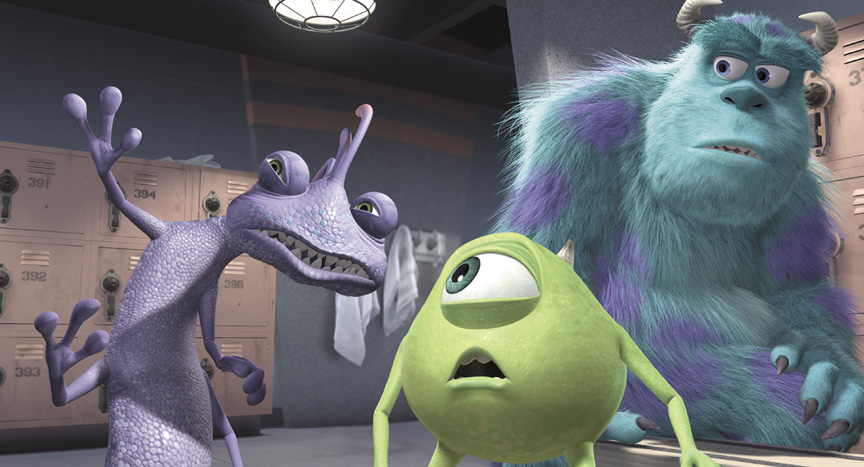
![]() To capture a
look and logic for Monstropolis, Pete Docter sent production designers
Harley Jessup and Bob Pauley on research trips to factories, refineries,
assembly plants, blimp hangars, and industrial towns. This included a trip
to Pittsburgh to examine the layout and inner-workings of an older company
town. Jessup explains, "We envisioned the Monsters, Inc. factory as sort
of a '60s era modernist building and the surrounding city has buildings
over 100 years old. The notion was that the turn-of-the-century factory
had been torn down and (the Monsters Inc. factory) was put up in the 1960s
during the heyday of the baby boom. Monsters Inc. is now about 40
years old and feeling outdated and a bit run down. There is an energy shortage
going on now (due to the fact that it's tougher to scare kids these days)
and business isn't what it used to be." He adds, "We were trying to make
sure that the monsters would be the most colorful things in Monstropolis,
so we made the city somewhat muted and the factory a bit on the cool side
colorwise. The brighter colors were saved for the characters themselves
so that they would really stand out. Our goal was to elevate the color
rhythms of the film and make sure we were saving different colors and light
qualities for the most dramatic moments."
To capture a
look and logic for Monstropolis, Pete Docter sent production designers
Harley Jessup and Bob Pauley on research trips to factories, refineries,
assembly plants, blimp hangars, and industrial towns. This included a trip
to Pittsburgh to examine the layout and inner-workings of an older company
town. Jessup explains, "We envisioned the Monsters, Inc. factory as sort
of a '60s era modernist building and the surrounding city has buildings
over 100 years old. The notion was that the turn-of-the-century factory
had been torn down and (the Monsters Inc. factory) was put up in the 1960s
during the heyday of the baby boom. Monsters Inc. is now about 40
years old and feeling outdated and a bit run down. There is an energy shortage
going on now (due to the fact that it's tougher to scare kids these days)
and business isn't what it used to be." He adds, "We were trying to make
sure that the monsters would be the most colorful things in Monstropolis,
so we made the city somewhat muted and the factory a bit on the cool side
colorwise. The brighter colors were saved for the characters themselves
so that they would really stand out. Our goal was to elevate the color
rhythms of the film and make sure we were saving different colors and light
qualities for the most dramatic moments."
![]() A first teaser
was presented in the Deluxe DVD edition of Toy
Story on October 6, 2000. A full
trailer was first shown on June 8, 2001.
A first teaser
was presented in the Deluxe DVD edition of Toy
Story on October 6, 2000. A full
trailer was first shown on June 8, 2001.
![]() Disney executives
asked the production team to tone down the scariest element of the movie
-they didn't want kids to be frightened by the characters and therefore
not want to buy plush toys.
Disney executives
asked the production team to tone down the scariest element of the movie
-they didn't want kids to be frightened by the characters and therefore
not want to buy plush toys.
![]() The movie was
pushed back from a summer 2001 to a November 2001 release, in August 2000.
Moreover, rumours flew in early November 2000 that Monsters Inc.
was way behind schedule and didn't look set to make its November 2001 release
date. Supposedly the reason for the slow progress was a lack of manpower:
Pixar doesn't have enough people on board to cover the extensive amount
work needed to complete the project on time. Another possible reason for
its rumoured delay is Pixar's planned move from their existing facilities
in Richmond, CA to Emeryville.
The movie was
pushed back from a summer 2001 to a November 2001 release, in August 2000.
Moreover, rumours flew in early November 2000 that Monsters Inc.
was way behind schedule and didn't look set to make its November 2001 release
date. Supposedly the reason for the slow progress was a lack of manpower:
Pixar doesn't have enough people on board to cover the extensive amount
work needed to complete the project on time. Another possible reason for
its rumoured delay is Pixar's planned move from their existing facilities
in Richmond, CA to Emeryville.
![]() Disney looked
to take the potential wind out of Harry Potter's sails by making
a big move up. Previously scheduled to hit screens for the Thanksgiving
weekend, the studio pushed up the release date of Monsters, Inc.
to November 2, 2001 which was be 2 weeks prior to the release of Harry
Potter and The Sorcerer's Stone on November 16.
Disney looked
to take the potential wind out of Harry Potter's sails by making
a big move up. Previously scheduled to hit screens for the Thanksgiving
weekend, the studio pushed up the release date of Monsters, Inc.
to November 2, 2001 which was be 2 weeks prior to the release of Harry
Potter and The Sorcerer's Stone on November 16.
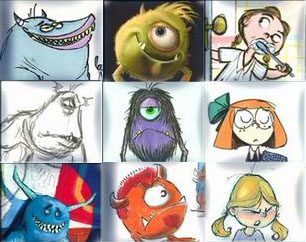
![]() Pixar prepared
a special trailer for Monsters Inc. to show before Harry Potter
and the Sorcerer's Stone (2001). Mike and Sulley play a game of charades
in their apartment, with Sulley acting out "Harry Potter". Mike has difficulty
solving the puzzle, even after Sulley wears a witch's hat, round spectacles,
and sits on a broom with an owl on his arm. One of his guesses is "When
Hairy met Sulley", a reference to Billy Crystal's starring role in When
Harry Met Sally (1989) . Just as Mike gets the puzzle, we cut away
to title cards noting that Monsters Inc. is "Now Playing at a theater
near you - really, really near you - like right next door".
Pixar prepared
a special trailer for Monsters Inc. to show before Harry Potter
and the Sorcerer's Stone (2001). Mike and Sulley play a game of charades
in their apartment, with Sulley acting out "Harry Potter". Mike has difficulty
solving the puzzle, even after Sulley wears a witch's hat, round spectacles,
and sits on a broom with an owl on his arm. One of his guesses is "When
Hairy met Sulley", a reference to Billy Crystal's starring role in When
Harry Met Sally (1989) . Just as Mike gets the puzzle, we cut away
to title cards noting that Monsters Inc. is "Now Playing at a theater
near you - really, really near you - like right next door".
![]() The original teaser
(where Mike and Sulley enter a room in "Outer Magnolia" instead of Outer
Mongolia) was also specially made and features material which did not appear
in the film. The scene from the trailer where Sulley tucks Boo into bed
and says, "Don't worry, I'll protect you," does not feature in the film,
either.
The original teaser
(where Mike and Sulley enter a room in "Outer Magnolia" instead of Outer
Mongolia) was also specially made and features material which did not appear
in the film. The scene from the trailer where Sulley tucks Boo into bed
and says, "Don't worry, I'll protect you," does not feature in the film,
either.
![]() Bill Murray was
considered and tested for the role of Sulley, but director Pete Docter
said that when the filmmakers decided to offer it to him they were unable
to make contact with him, and took that to mean "no".
Bill Murray was
considered and tested for the role of Sulley, but director Pete Docter
said that when the filmmakers decided to offer it to him they were unable
to make contact with him, and took that to mean "no".
![]() Bonnie Hunt’s
role as the training monster Flint was originally much larger. Unfortunately
for Hunt’s fans, her role was cut down to a mere cameo.
Bonnie Hunt’s
role as the training monster Flint was originally much larger. Unfortunately
for Hunt’s fans, her role was cut down to a mere cameo.
![]() Ted, the rather
large, green-scaly monster we only see from the knees down on Sulley and
Mike’s walk to work, was originally going to have a familiar monster-movie
roar (think Japan). But rights issues couldn’t be met, so he ended up with
the voice of ... a chicken.
Ted, the rather
large, green-scaly monster we only see from the knees down on Sulley and
Mike’s walk to work, was originally going to have a familiar monster-movie
roar (think Japan). But rights issues couldn’t be met, so he ended up with
the voice of ... a chicken.
![]() An original story
idea for Celia (whose full name is reveled, Celia Mae) was to give her
the ability to turn people into stone, a nod to her Medusa like hair-do.
An original story
idea for Celia (whose full name is reveled, Celia Mae) was to give her
the ability to turn people into stone, a nod to her Medusa like hair-do.
![]() All the kid’s
screams were recorded by actual children, mostly those belonging to Pixar
staff members.
All the kid’s
screams were recorded by actual children, mostly those belonging to Pixar
staff members.
![]() Cinematic homages
within Monsters, Inc. include The Right Stuff (not Armageddon),
Brazil
and Barry Lyndon.
Cinematic homages
within Monsters, Inc. include The Right Stuff (not Armageddon),
Brazil
and Barry Lyndon.
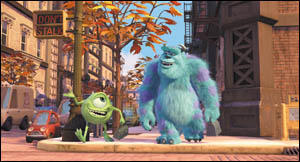
![]() Randall’s scare
assistant Fungus is voiced by Frank Oz of Muppet/Yoda fame
Randall’s scare
assistant Fungus is voiced by Frank Oz of Muppet/Yoda fame
.
![]() All of Boo’s
drawings in the film were authentic kid drawings that were then scanned
into the computer for use in the film.
All of Boo’s
drawings in the film were authentic kid drawings that were then scanned
into the computer for use in the film.
![]() When Sulley wakes
up, his clock-radio changes to 6:05 and we hear the weather news--a reference
to Bull Murray's Groundhog Day (1993).
When Sulley wakes
up, his clock-radio changes to 6:05 and we hear the weather news--a reference
to Bull Murray's Groundhog Day (1993).
![]() Sulley’s feathery
blue green-and-purple-spotted coat includes nearly 3 million individual
hairs -- made possible by breakthroughs in computer animation.
Sulley’s feathery
blue green-and-purple-spotted coat includes nearly 3 million individual
hairs -- made possible by breakthroughs in computer animation.
![]() Early versions
of the story involved a 32-year-old man who had monsters appear that only
he could see. But as the story developed, the filmmakers realized a little
girl would make the best foil to the 8-foot tall, 800-pound Sulley.
Early versions
of the story involved a 32-year-old man who had monsters appear that only
he could see. But as the story developed, the filmmakers realized a little
girl would make the best foil to the 8-foot tall, 800-pound Sulley.
![]() Sulley went through
some monster-sized changes as the story developed – from a janitor to a
down-on-his-luck loser to the superstar scarer he ended up being. At one
point, he even wore glasses and had tentacles!
Sulley went through
some monster-sized changes as the story developed – from a janitor to a
down-on-his-luck loser to the superstar scarer he ended up being. At one
point, he even wore glasses and had tentacles!
![]() One of the filmmakers’
biggest challenges was to come up with a reason for the monsters to scare
kids. At one point, they played with the idea that the monsters entertained
each other by scaring children.
One of the filmmakers’
biggest challenges was to come up with a reason for the monsters to scare
kids. At one point, they played with the idea that the monsters entertained
each other by scaring children.
![]() Mary Gibbs [Boo]
was so young that it proved difficult to get her to stand in the recording
studio and act her lines. Instead, they simply followed her around with
a microphone and cut Boo's lines together from the things she said while
she played.
Mary Gibbs [Boo]
was so young that it proved difficult to get her to stand in the recording
studio and act her lines. Instead, they simply followed her around with
a microphone and cut Boo's lines together from the things she said while
she played.
![]() Boo's real name
is Mary, as shown briefly on one of the crayon drawings she shows to Sulley
in the scene where Boo is going to sleep on Sulley's bed.
Boo's real name
is Mary, as shown briefly on one of the crayon drawings she shows to Sulley
in the scene where Boo is going to sleep on Sulley's bed.
![]() The controls for
the Monsters Inc. door mechanisms include a button that starts the process
labeled "FIZT" - Fiz-T is in reality the latest software developed by Pixar
Animation Studios to realistically render complex physical models - notably
in this film to model Sulley's fur and Boo's clothing.
The controls for
the Monsters Inc. door mechanisms include a button that starts the process
labeled "FIZT" - Fiz-T is in reality the latest software developed by Pixar
Animation Studios to realistically render complex physical models - notably
in this film to model Sulley's fur and Boo's clothing.

![]() The last half
of Chuck Jones' 1952 classic Feed the Kitty short cartoon is included
scene-for-scene when Sulley thinks that Boo has been thrown in the trash
compactor. Each of Marc Antony's overdone reactions is echoed by Sulley
against the window.
The last half
of Chuck Jones' 1952 classic Feed the Kitty short cartoon is included
scene-for-scene when Sulley thinks that Boo has been thrown in the trash
compactor. Each of Marc Antony's overdone reactions is echoed by Sulley
against the window.
![]() The cloud wallpaper
from Andy's room in Toy Story (1995)
is seen briefly as one of the wallpapers that Randall uses to test his
chameleon skills against.
The cloud wallpaper
from Andy's room in Toy Story (1995)
is seen briefly as one of the wallpapers that Randall uses to test his
chameleon skills against.
![]() One of the children's
rooms the monsters go into has a Paul Bunyon poster on the wall. Sid's
room in Toy Story had a Paul Bunyon
poster in it (possibly even the same poster).
One of the children's
rooms the monsters go into has a Paul Bunyon poster on the wall. Sid's
room in Toy Story had a Paul Bunyon
poster in it (possibly even the same poster).
![]() The slow-motion
scene in which the scarers enter the scare floor parodies the arrival of
the astronauts in The Right Stuff (1983) which was itself pastiched
in Armageddon (1998) where Steve Buscemi played one of the pilots.
The slow-motion
scene in which the scarers enter the scare floor parodies the arrival of
the astronauts in The Right Stuff (1983) which was itself pastiched
in Armageddon (1998) where Steve Buscemi played one of the pilots.
![]() The Snowman describes
the children in the Himalayan village as "Tough kids, sissy kids, kids
who climb on rocks", a line taken from an old jingle for Armor hot dogs.
The Snowman describes
the children in the Himalayan village as "Tough kids, sissy kids, kids
who climb on rocks", a line taken from an old jingle for Armor hot dogs.
![]() There are retro
Disneyland posters in the Monstropolis travel store and some of the children's
bedrooms.
There are retro
Disneyland posters in the Monstropolis travel store and some of the children's
bedrooms.
![]() The restaurant
that Wazowski and Celia are at is called the Harryhausen. This is an homage
to Ray Harryhausen, the man who made the stop-motion animation monsters
for films like Jason and the Argonauts (1963).
The restaurant
that Wazowski and Celia are at is called the Harryhausen. This is an homage
to Ray Harryhausen, the man who made the stop-motion animation monsters
for films like Jason and the Argonauts (1963).
![]() When Sulley is
about to say goodbye to Boo, Boo is trying to get him to play. She hands
him a Jessie doll from Toy Story 2
(1999) as well as Nemo the clownfish from Finding
Nemo (2003). The yellow ball with the red star on the floor is
the ball from the Pixar animation, Luxo Jr. [thanks to 'Christopher
Clegg' for the information]. Finding Nemo co-director Lee
Unkrich later revealed that "Nemo actually makes two cameos in Monsters
Inc.: he also shows up when Randall gets jettisoned at the very end
of the film into the backwoods swamp trailer: you catch a little glimpse
into the inside of the trailer, and you can see Nemo mounted on a plaque."
When Sulley is
about to say goodbye to Boo, Boo is trying to get him to play. She hands
him a Jessie doll from Toy Story 2
(1999) as well as Nemo the clownfish from Finding
Nemo (2003). The yellow ball with the red star on the floor is
the ball from the Pixar animation, Luxo Jr. [thanks to 'Christopher
Clegg' for the information]. Finding Nemo co-director Lee
Unkrich later revealed that "Nemo actually makes two cameos in Monsters
Inc.: he also shows up when Randall gets jettisoned at the very end
of the film into the backwoods swamp trailer: you catch a little glimpse
into the inside of the trailer, and you can see Nemo mounted on a plaque."
![]() Randall Boggs
is last seen in a tractor-trailer. There is a Pizza Planet truck from Toy
Story (1995) and Toy Story 2
(1999) beside the trailer and the trailer was featured in A
Bug's Life (1998). The man inside the trailer is the Pizza Planet
deliveryman.
Randall Boggs
is last seen in a tractor-trailer. There is a Pizza Planet truck from Toy
Story (1995) and Toy Story 2
(1999) beside the trailer and the trailer was featured in A
Bug's Life (1998). The man inside the trailer is the Pizza Planet
deliveryman.
![]() When Sulley shows
the pile of trash (he thinks Boo is inside) to Mike, the sound the little
lamp made in Luxo Jr. (1986) can be heard.
When Sulley shows
the pile of trash (he thinks Boo is inside) to Mike, the sound the little
lamp made in Luxo Jr. (1986) can be heard.
![]() When Boo pulls
on the stacked DVDs in Sullivan's apartment and they all come falling down,
the DVD she's holding can be seen to be A Bug's
Life.
When Boo pulls
on the stacked DVDs in Sullivan's apartment and they all come falling down,
the DVD she's holding can be seen to be A Bug's
Life.
![]() Pete's Barber
Shop is named for director Pete Docter. The Hidden City Cafe is a real
restaurant in California, which is a favorite of Docter's.
Pete's Barber
Shop is named for director Pete Docter. The Hidden City Cafe is a real
restaurant in California, which is a favorite of Docter's.
![]() This is the fourth
movie to feature both John Goodman and Steve Buscemi and is the first of
the four not to be directed and produced by Joel Coen and Ethan Coen.
This is the fourth
movie to feature both John Goodman and Steve Buscemi and is the first of
the four not to be directed and produced by Joel Coen and Ethan Coen.
![]() Almost at the
end of the credits a disclaimer states that "No monsters were harmed in
the making of this movie".
Almost at the
end of the credits a disclaimer states that "No monsters were harmed in
the making of this movie".
![]() A week before
the movie's release, director Pete Docter admitted he wasn't ready to commit
to a follow-up just yet, despite industry buzz about a sequel. "I would
have to think about that and see what happens. At this point I'm relieved
to be done with this film. It's been a long process. I'm happy with the
film, but I haven't thought about a sequel." When asked if he would work
for Pixar again, actor Billy Crystal answered he was already psyched to
do a sequel: "In a second! It's so unique an experience because you're
working in the dark and you just trust. But you're in the hands of the
best people to do this -- so that's a great thing. It's so astounding what
you can accomplish, the good that you can do!"
A week before
the movie's release, director Pete Docter admitted he wasn't ready to commit
to a follow-up just yet, despite industry buzz about a sequel. "I would
have to think about that and see what happens. At this point I'm relieved
to be done with this film. It's been a long process. I'm happy with the
film, but I haven't thought about a sequel." When asked if he would work
for Pixar again, actor Billy Crystal answered he was already psyched to
do a sequel: "In a second! It's so unique an experience because you're
working in the dark and you just trust. But you're in the hands of the
best people to do this -- so that's a great thing. It's so astounding what
you can accomplish, the good that you can do!"
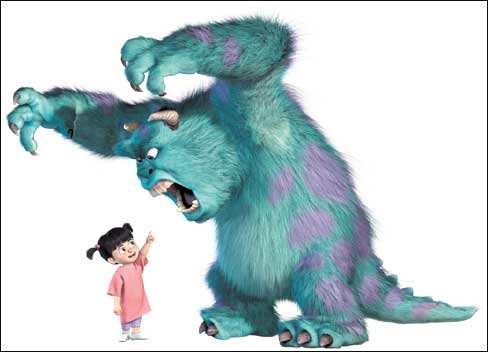
![]() Outtakes were
released on December 7, a month after the movie's release, in time for
the holidays, in order to generate repeat business. At that time, Monsters
was starting to seriously lose steam at the box-office and the prospect
of topping Shrek's record was getting thinner every day.
Outtakes were
released on December 7, a month after the movie's release, in time for
the holidays, in order to generate repeat business. At that time, Monsters
was starting to seriously lose steam at the box-office and the prospect
of topping Shrek's record was getting thinner every day.
![]() Steve Jobs announced
in February 2002 that Monsters, Inc. would not be released on VHS
and DVD until Fall 2002. But the Pixar CEO promised that the DVD mega-set
would "break new ground," and with DVD player penetration rapidly growing,
Pixar thinks "it's likely DVD units will exceed VHS units - a first for
a Pixar release."
Steve Jobs announced
in February 2002 that Monsters, Inc. would not be released on VHS
and DVD until Fall 2002. But the Pixar CEO promised that the DVD mega-set
would "break new ground," and with DVD player penetration rapidly growing,
Pixar thinks "it's likely DVD units will exceed VHS units - a first for
a Pixar release."
![]() Monsters, Inc.
was nominated for four Academy Awards: Best Sound Editing, Best Animated
Feature, Best Score and Best Song. It only won for the latest category:
composer Randy Newman performed "If I Didn't Have You" with John Goodman
at the Oscars. Minutes later, he had lost his fifteenth nomination (Best
Score), tying with composer Alex North and art director Roland Andersonfor
the record of most Oscar nominations without a win. "I don't want your
pity. I want to thank the music branch for giving me so many opportunities
to be humiliated! The picture deserves recognition. All four of the Pixar/Disney
movies do." He went on to add backstage that "that’s all due to John Lasseter
and the guys at Pixar. I’m not really a jazz man, but that’s the sound
that they wanted and they’re always listening to jazz up there."
Monsters, Inc.
was nominated for four Academy Awards: Best Sound Editing, Best Animated
Feature, Best Score and Best Song. It only won for the latest category:
composer Randy Newman performed "If I Didn't Have You" with John Goodman
at the Oscars. Minutes later, he had lost his fifteenth nomination (Best
Score), tying with composer Alex North and art director Roland Andersonfor
the record of most Oscar nominations without a win. "I don't want your
pity. I want to thank the music branch for giving me so many opportunities
to be humiliated! The picture deserves recognition. All four of the Pixar/Disney
movies do." He went on to add backstage that "that’s all due to John Lasseter
and the guys at Pixar. I’m not really a jazz man, but that’s the sound
that they wanted and they’re always listening to jazz up there."
![]() Monsters, Inc.
soared past the $500 million mark at the worldwide box office in April
2002, to become the second highest grossing animated film of all-time,
behind only Disney's The Lion King.
Monsters,
Inc.'s blockbuster performance of $504 million to date was comprised
of $253 million in domestic box office receipts and $251.2 million in international
box office receipts, where it set records in Japan ($59.1 million, the
most successful U.S. animated film ever), England ($53 million), Mexico
($20.1 million) and Spain ($13.5 million).
Monsters, Inc.
soared past the $500 million mark at the worldwide box office in April
2002, to become the second highest grossing animated film of all-time,
behind only Disney's The Lion King.
Monsters,
Inc.'s blockbuster performance of $504 million to date was comprised
of $253 million in domestic box office receipts and $251.2 million in international
box office receipts, where it set records in Japan ($59.1 million, the
most successful U.S. animated film ever), England ($53 million), Mexico
($20.1 million) and Spain ($13.5 million).
![]() Director Peter
Docter addressed the rumors of a sequel in an August 2002 interview: "So
far we've talked about it here and there, but really what it comes down
to is the same with Toy Story 2, is
that we just had this great idea: 'Oh, this has got to be done.' So far
we haven't come up with that great idea for Monsters.
We're thinking about it, but it really won't make any sort of headway until
we come up with the really killer idea. It's idea driven." Meanwhile, Pete
Docter was in the very early stage of develpoment for his next feature,
set for a tentative 2007 release date.
Director Peter
Docter addressed the rumors of a sequel in an August 2002 interview: "So
far we've talked about it here and there, but really what it comes down
to is the same with Toy Story 2, is
that we just had this great idea: 'Oh, this has got to be done.' So far
we haven't come up with that great idea for Monsters.
We're thinking about it, but it really won't make any sort of headway until
we come up with the really killer idea. It's idea driven." Meanwhile, Pete
Docter was in the very early stage of develpoment for his next feature,
set for a tentative 2007 release date.
![]() The Pixar blockbuster
set home-video records by selling 5 million units on DVD and video
in North America on its first day of availability, and 7 million DVDs during
its opening week of release in September 2002. The overall home-video record
for first week sales remains with Disney's The
Lion King, which sold 20 million copies its first week in stores
(vs. 11 million for Monsters, Inc.) during the pre-DVD era. "For
a movie with such family appeal, we never could have expected to do this
well on DVD," commented Bob Chapek, president of Disney's Buena Vista Home
Entertainment.
The Pixar blockbuster
set home-video records by selling 5 million units on DVD and video
in North America on its first day of availability, and 7 million DVDs during
its opening week of release in September 2002. The overall home-video record
for first week sales remains with Disney's The
Lion King, which sold 20 million copies its first week in stores
(vs. 11 million for Monsters, Inc.) during the pre-DVD era. "For
a movie with such family appeal, we never could have expected to do this
well on DVD," commented Bob Chapek, president of Disney's Buena Vista Home
Entertainment.
![]() At a press conference
lin December 2002, Billy Crystal admitted that he would love to again lend
his voice to Mike Wazowski: "I hope [they'll ask me to come back for a
sequel], because I hear they pay on those." In a serious tone he added,
"I really hope they do. I had a great time doing that. And obviously people
liked the movie and it was a big success. But I really had a good time,
so I look forward to that." Steve Jobs confirmed during the First Quarter
2003 Earnings conference on May 7, 2003 that "we've got some ideas for
a Monsters sequel."
At a press conference
lin December 2002, Billy Crystal admitted that he would love to again lend
his voice to Mike Wazowski: "I hope [they'll ask me to come back for a
sequel], because I hear they pay on those." In a serious tone he added,
"I really hope they do. I had a great time doing that. And obviously people
liked the movie and it was a big success. But I really had a good time,
so I look forward to that." Steve Jobs confirmed during the First Quarter
2003 Earnings conference on May 7, 2003 that "we've got some ideas for
a Monsters sequel."
![]() However, John
Goodman revealed in February 2003 that "as far as I know, the guys at Pixar
are opposed to a Monsters Inc. sequel. They said there's no reason
to do one unless someone comes up with a really good second storyline.
I think they're more interested in doing little shorts like Mike's New
Car, which featured Sulley. Monsters, Inc. was special because
they had Billy Crystal and me in the studio together, so we could improvise
on the script they gave us."
However, John
Goodman revealed in February 2003 that "as far as I know, the guys at Pixar
are opposed to a Monsters Inc. sequel. They said there's no reason
to do one unless someone comes up with a really good second storyline.
I think they're more interested in doing little shorts like Mike's New
Car, which featured Sulley. Monsters, Inc. was special because
they had Billy Crystal and me in the studio together, so we could improvise
on the script they gave us."
![]() Finding Nemo's
co-director Lee Unkrich commented in June 2003 that "we hear a lot of demand
for Monsters 2, but that's not on the list right now. A lot of us
at Pixar would love to do another Toy Story,
but there are no concrete plans."
Finding Nemo's
co-director Lee Unkrich commented in June 2003 that "we hear a lot of demand
for Monsters 2, but that's not on the list right now. A lot of us
at Pixar would love to do another Toy Story,
but there are no concrete plans."
![]() According to a
March 2003 rumor, the Superstar Limo attraction that has been sitting idle
for the last year at Disneyland "will soon be turned into a new Monsters
Inc. attraction. It will be a dark ride like the classics in Fantasyland
(Peter Pan, Snow White, etc...)."
According to a
March 2003 rumor, the Superstar Limo attraction that has been sitting idle
for the last year at Disneyland "will soon be turned into a new Monsters
Inc. attraction. It will be a dark ride like the classics in Fantasyland
(Peter Pan, Snow White, etc...)."
October 2001 interviews with John
Goodman - Billy Crystal, - Steve
Buscemi - John Lasseter and Pete Docter.
By Paul Fischer in Los Angeles, courtesy of
Dark
Horizons.
What is your attraction to animation?
John Goodman: Well, I started doing it for my daughter, but in a couple years she'll probably be too old for this stuff. I listened to a lot of radio theatre when I was a kid and I've always been a fan of that stuff.
Did you have a deal with Disney?
John Goodman: No. They started this about halfway through Emperor's New Groove and then started doing Jungle Book II about three quarters of the way through this.
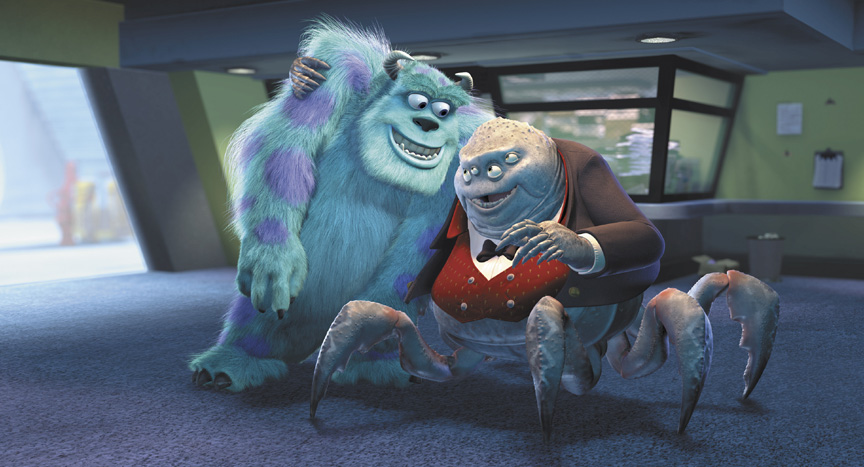 If
animation is for your daughter, what are roles like Coyote Ugly
for?
If
animation is for your daughter, what are roles like Coyote Ugly
for?
John Goodman: For the money. Honest to God, that's the only reason I did it.
How much improv is involved?
John Goodman: We would read the scripts and they usually don't let actors read together. They usually read them one at a time with a producer or a director, but this time they brought Billy and I together, I guess to see what would happen. The energy just took off like a rocket. So, Billy, after we'd get done with the script, he'd kind of take over and do whatever he wanted and I'd just try to keep up with him.
Whose idea was it to sing the end song?
John Goodman: Well, Randy Newman was always doing the score and then he wrote the song and I've always been a huge fan of his. I just think he's the best. We did it pretty much after we wrapped everything else.
Will you take that song on the road now?
John Goodman: Yeah, I think we ought to do it at the Oscars next year.
Is computer animation a different process for you than traditional?
John Goodman: No. It's just you and a microphone, so it's the same principle. There's no difference at all.
You were never in the same room?
John Goodman: No, we were. They did bring us together.
Do you get anything for the dolls?
John Goodman: I have nothing to do with it. I don't think I signed any merchandizing deals.
Where did your monsters hide?
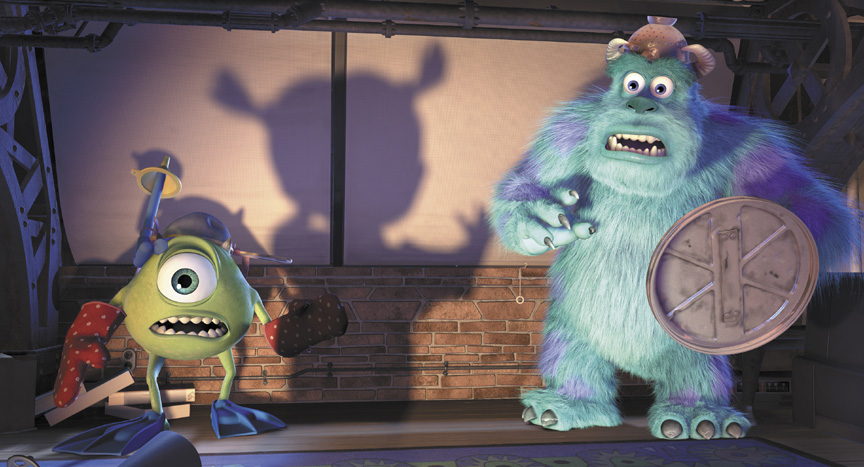
John Goodman: Under the bed, not the closet. After a while I
got hip and started getting a broom stick, pushing it under there. Yeah,
I had all kinds of crap in my closet. There's no way one could've survived
in there with my sneakers alone.
Where did the comedian come from in you?
John Goodman: Desperation. I don't know, I've always looked at the world kind of weird.
How?
John Goodman: I just always liked to laugh.
Was there one particular monster that was worse than the others?
John Goodman: Frankenstein. Scared the hell out of me. They used to have a show called This is your Life. One night Boris Karloff was on and I made the mistake of watching it. So, that night, I knew he was coming for me and I got up. I don't know why, but I could actually see him walk down the hall and I ran into my mom's room. "What are you doing in here? Oh, no he's not. Go back to bed."
Did the broomstick help against him?
John Goodman: Well, once you went under the bed, through the closet, hit the bed again, and then you were good to go. And I invented bullet proof sheets so they couldn't kill me.
Have you kept in touch with Roseanne?
John Goodman: Rose called about six months ago, just to check up, see what I was doing. But no, I haven't talked to her for a while. I hope she's doing all right. She looks great.
Have you gone on her talk show?
John Goodman: Yeah. It was weird. The last time, she was determined to sing the blues so I wound up playing harmonica behind her. She started improvising lyrics and it went on for about a half hour.
Did you see what Sullivan looked like?
John Goodman: Oh, yeah. From jump street, they had the illustrations and computer stuff. It's a long process, so it would be maybe two months later I'd come back and they'd have more stuff done and show me how they incorporated - they videotape you when you're reading so they incorporate some of your gestures and your facial expressions.
Are you Baloo in Jungle Book II?
John Goodman: Yeah.
Was that fun?
John Goodman: Yeah. We did a couple pretty good songs. It's just everybody remembers Phil Harris from it. I try not to imitate him but go along those lines, so it is kind of a challenge.
Any of the same songs?
John Goodman: Well, there's a small repetition of "The Bear Necessities".
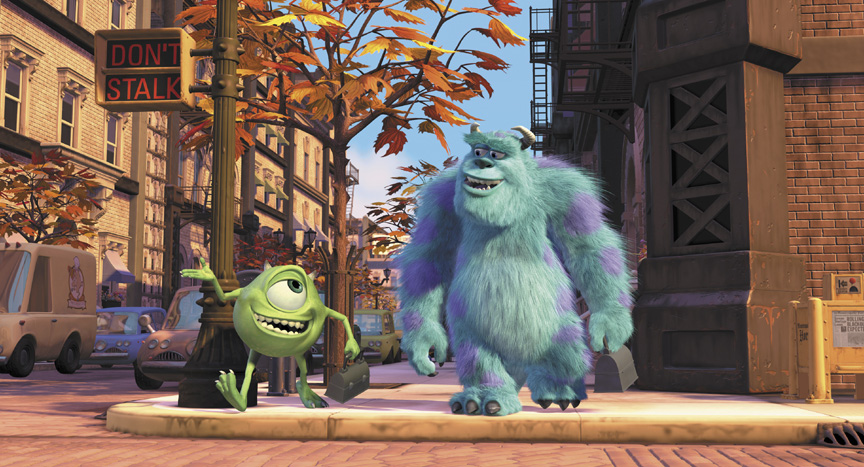
Do you like singing?
John Goodman: Yeah. Unfortunately, I'm not very good at it anymore, not that I ever really burnt the house down, but I just smoked too many cigarettes. My voice isn't what it should be.
Do your kids have monsters they hide from?
John Goodman: My daughter, I have an 11 year old daughter and we had just gotten her out of my bedroom when the big earthquake hit. So, that was a big monster there. She was afraid of that for a while.
How important is it for the kids to have this movie now?
John Goodman: It's tough for me to comment on something like that because anything I say is going to sound self-serving. I think in times of crisis, entertainment's always been important.
This one has a positive message?
John Goodman: About fear. I feel a little weird talking about
it now.
What made you want to do a kids' movie?
Billy Crystal: I didn't think of this as a kids' movie when I did it. I thought it was great. The concept of it was fantastic. I knew the audience that would come to see this would be adults and kids and the older, wrinkled kids will love this movie too.
Did you do a lot of improv in the recording studio that they couldn't use?
Billy Crystal: Yeah but I thought they should have pushed a little bit more. I thought, in tone, it could have been a little edgier but when you see it you go, 'this is joyful and great.'
You and John (Goodman) were working together. That's very rare in a voice session.
Billy Crystal: I kept pushing for it. I did the first two sessions alone and I didn't like it. It was lonely and it was frustrating. And, you know Pete (Docter, the director) would say, could you give me one that's. doing the same thing but now ask it as a question. And I would go 'Why?' like 'I'm not doin' this'. Now should I say 'Should I do this? well, in case I change the scene. I said 'Why don't you get John in here? We'll do it together and we can do everything you want but we'll do it together. Then it'll be natural. Then the editor won't be the one who has to put it all together so it sounds real. It'll just be real. Then we did it and it was great.
Were you uncontrollable when you were working together? Would you
go off on all sorts of tangents?

Billy Crystal: Good ones. As a director and an actor, I encourage
improvisation but in character and in the moment of what it is. My guy
I thought was free enough and wild enough to just do anything. And it's
up to them to pick the ones they want and use it. I kept saying to Pete,
'No, go. It's a little darker but at least have it. They why was everybody
screaming and laughing in the control booth if you're not gonna use it?
You want me here, I'm gonna give ya'. It's a smorgasbord. Take the ones
that are good'.
Did you fight for your character to have more than one eye?
Billy Crystal: No. I wanted him to have balls. We found out that he did in that one scene. Evidently something hurt. They don't give you a thumb and they don't give you balls. I don't know which one I'd rather have because if you have balls and no thumb you can't hold onto 'um anyway.
What about your own monsters when you were a kid and were did they hide?
Billy Crystal: Relatives and they hid in Brooklyn. I didn't have a specific monster guy. I had generalized anxiety which is worse. I had fears of the dark, you know, I didn't like being in the dark, I didn't like seeing sounds bothered me. I had really good hearing and when you're scared it gets heightened so you hear scratching noises or something. We'd had some burglaries in the area, always someone breaking in. That was the thing. If you're home alone who's gonna take care of you. Who's gonna fend off the whatever it was. Just the unknown. It was a tiny little house. There wasn't room for much. My room was in the back and I didn't like the dark so I would say 'Keep the light on'. I stopped doing that around two or three years ago. I keep the door open a little bit.
Was this is Brooklyn?
Billy Crystal: No. Long Island.
Was there a particular movie monster that may have scared you?
Billy Crystal: There were some pretty scary movies back then which now seem not as scary to some people But Psycho, as a kid, was just terrifying. Bambi, to a kid, was scary.
Was there an animated film you were attached to?
Billy Crystal: Yeah, Pinocchio. It's a great story, the little boy. You could relate to the kid. Jiminy Cricket was a phenomenal character. The epic animation, the whale, Cleo, all the other stuff that Disney was able to put in movies, amazing ideas. It's still great. People are excited that Snow White came out on DVD.
Someone calls you to do an animated movie. What do you do?
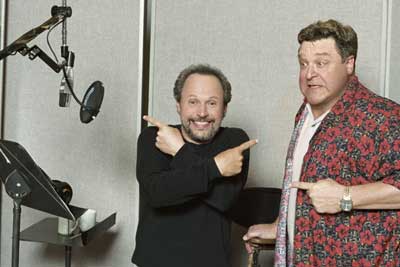 Billy
Crystal: If it's John Lasseter who
calls me, I go where do I sign and when do I start? I loved this idea.
They brought a piece, about 35, 40 seconds of him animated with my voice
lines from My Giant I realized. 'The size of the hero is determined
by the size of the villain. Without Goliath, David is just some kid throwing
rocks'. It was this over and over again with this guy talkin' and movin'
his hands. Stuff like that and they told me the concept and brought some
storyboards and paintings and Pete explained the movie and that was it.
I just thought it was epic. And when I sat and saw the movie for the first
time the other night, getting back to what you said before, the first thing
that hit me hard in a great way was seeing Walt Disney Presents. It hit
me hard and I went (takes in a breath) and my wife went 'What's the matter?'
and I went 'This is big'. You have to eliminate Walt Disney company like
we know it today. What it started out to be was what influenced me as a
kid. My mother was the voice of Minnie Mouse for a little while in the
Macy's Day parades in New York. She would do the recordings of Minnie's
voice in the floats of Minnie coming down 5th Avenue with this big four
story Minnie Mouse and my mother was Minnie's voice. So I heard that but
the movies, the Mouse Club. I remember, as a kid watching on our black
and while set this big (indicates tiny) Walt with a hard hat ploughing
Disneyland and putting up this entertainment land with its future highway.
It looks like this guy is everybody's uncle. To be part of the legacy of
Snow
White and Pinocchio and Old
Yeller and Davy Crockett and the Mouse Club and Annette and
now the Pixar movies which he would be thrilled about. When I saw 'Walt
Disney' at the head of this movie, I got all excited to be part of that
legacy.
Billy
Crystal: If it's John Lasseter who
calls me, I go where do I sign and when do I start? I loved this idea.
They brought a piece, about 35, 40 seconds of him animated with my voice
lines from My Giant I realized. 'The size of the hero is determined
by the size of the villain. Without Goliath, David is just some kid throwing
rocks'. It was this over and over again with this guy talkin' and movin'
his hands. Stuff like that and they told me the concept and brought some
storyboards and paintings and Pete explained the movie and that was it.
I just thought it was epic. And when I sat and saw the movie for the first
time the other night, getting back to what you said before, the first thing
that hit me hard in a great way was seeing Walt Disney Presents. It hit
me hard and I went (takes in a breath) and my wife went 'What's the matter?'
and I went 'This is big'. You have to eliminate Walt Disney company like
we know it today. What it started out to be was what influenced me as a
kid. My mother was the voice of Minnie Mouse for a little while in the
Macy's Day parades in New York. She would do the recordings of Minnie's
voice in the floats of Minnie coming down 5th Avenue with this big four
story Minnie Mouse and my mother was Minnie's voice. So I heard that but
the movies, the Mouse Club. I remember, as a kid watching on our black
and while set this big (indicates tiny) Walt with a hard hat ploughing
Disneyland and putting up this entertainment land with its future highway.
It looks like this guy is everybody's uncle. To be part of the legacy of
Snow
White and Pinocchio and Old
Yeller and Davy Crockett and the Mouse Club and Annette and
now the Pixar movies which he would be thrilled about. When I saw 'Walt
Disney' at the head of this movie, I got all excited to be part of that
legacy.
Weren't you supposed to be in Toy Story?
Billy Crystal: Yeah. It just didn't work out at the time. And then when John came with this one. I've seen the tests of me as Buzz Lightyear. They used lines from Harry Met Sally which was hysterical. First you see Buzz, then you see the lines were from the wagon wheel coffee table scene. 'Someday, we're gonna go 15 rounds over who's gonna own this coffee table. This stupid, wagonwheel coffee table' and it's Buzz and then he walks away and the shot widened out and he was underneath the coffee table and you hear Bruno Kirby say, 'I thought you liked it' and little Buzz screams 'I was being nice'. That was the test when they were sampling voices. I never knew this. They had taken lines and animated this little section which I have. It's hilarious.
Now that's a good DVD addition.
Billy Crystal: Yeah but I've got to say though, I wasn't right
for it. Tim was fantastic in that character. He was appropriately vacant
, really and the quality of his voice was so full of shit like those movie
star guys are, those space guys. And he was perfect. This (pointing at
stuffed toy of his character) is my guy.
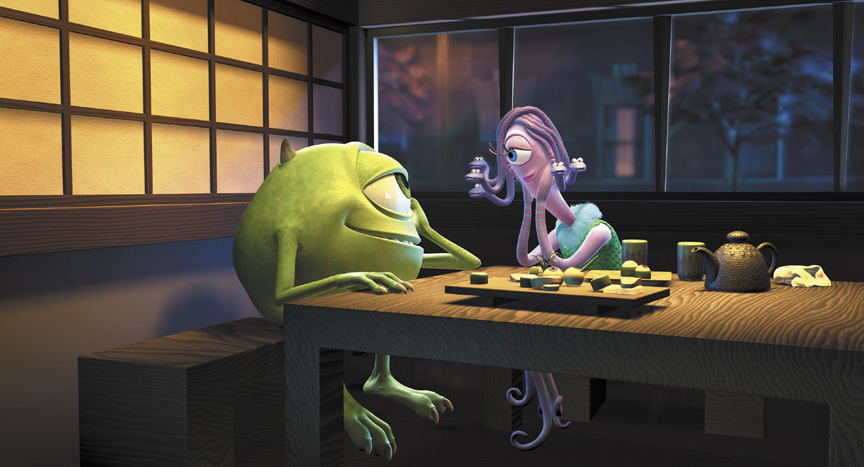
Given current event with kids being inundated both at home and at
school, what does it mean to have this kind of film for kids to see at
this point?
Billy Crystal: At ANY time this movie is a great movie. You know, now when it deals with fear and laughter and overcoming terror and all that stuff that's obviously an added thing for them. But, this is a great enjoyment for everybody. What I love about the movie, at any time, is that families can go see it together and it should provoke thought and discussion about fear and about kids, you know sometimes when they're afraid of something, they won't tell their parents because they think something's wrong with them. 'I saw a monster and monsters aren't real'. Sometimes they'll run into the room and say 'I saw a monster' but, if they talk about it, maybe they won't have so many.
Did your kids do that?
Billy Crystal: I still do it.
Did you see Shrek? I assume that and Monsters Inc. are in the running for the Oscar?
Billy Crystal: I think this is a worthy movie of any kind to
me. I think Shrek was terrific. They're just very different. The
level of difficulty in this movie is extraordinary because of the story
it has to tell and the levels of maturity to it. Shrek is a fantastic
fable, really funny and it's great too. They're just different.
How would you describe the experience of doing animation?
Steve Buscemi: It's interesting, and requires a lot of faith in your directors, which I did, and I really trusted him with what THEY were doing, and the film that they wanted to make, and it was a lot of fun.
How did the experience of making Monsters compare to the experience of doing Final Fantasy?
Steve Buscemi: The character of Randall was a little bit more over the top, while the character in Final Fantasy well, he was a little bit of an excitable character, but one was human and the other was a monster, so I guess playing the monster meant you had a bit more freedom to go over-the-top.
Were there any different TECHNICAL challenges in both cases?
Steve Buscemi: Not for me. For me, it was just a voice. The process is really the same.
Did they look at you or your mannerisms before completely formulating the character?
Steve Buscemi: When you are recording the voice, even before you are doing it to picture, they videotape you doing it to see the expressions on your face, and I think they DO try and incorporate some of that.
How surprised are you by the final creation of this character? Do you play any kind of role in overseeing the development of the character while the film is in production?
Steve Buscemi: They pretty well showed me what the character was going to look like from the very beginning. I liked the character and thought he looked great. I liked the big eyes and the fact that he was this lizard-like monster.
Did the scope of the character or anything about him change as you
went through the process of revoicing him?

Steve Buscemi: I just remember his name changed, but I can't
remember what his original name was. I don't remember there being too many
changes with the character. I can tell you that this is a process of over
2 years so you kind of do it, then you do the first session, then you forget
about it then you come back and sometimes it was hard to remember where
I was in the story or how it was progressing. So Pete really had to keep
me informed about what was going on, so it was a very abstract way of acting,
but I enjoyed it.
How long did you record?
Steve Buscemi: Over a period of 2 years.
Where did your monsters hide?
Steve Buscemi: DEFINITELY under the bed. When I was that young, I shared the bed with my two brothers and we definitely talked about the monsters being under the bed. You'd be afraid to let your arm drop down and hang off; that was way too scary.
Where was this?
Steve Buscemi: In Brooklyn. Also, I remember being afraid of the headlights that came in through the window late at night and just the way the lights would travel across the bed and up the walls and ceiling. It was explained to me it was just a car, but for some reason that was just eerie.
What were some of YOUR favourite animated films growing up?
Steve Buscemi: Pinocchio was a lot of fun, because I liked the songs in it. It was also scary as well having jokes in it that my parents appreciated. I just LOVED that character and the song 'An Actor's Life for Me'.
Are you excited about your children seeing Monsters Inc?
Steve Buscemi: I have one son and we saw a screening of it, he brought a friend and they were very excited about seeing it before it was released. They really loved it. It's nice to be able to do something that my son can actually see, that most of the stuff I do he's gonna have to wait till he's 17.
Does doing an animated movie like Monsters, bring out the child in you?
Steve Buscemi: Yeah. I mean acting in general is very childlike because you're pretending to be somebody else, so it doesn't matter what the situation is, or how serious the film is, I think acting IS very childlike, and this is just pure fun, and it probably DOES bring out the child in you a little bit more.
Is it more liberating doing an animated film?
Steve Buscemi: Yeah, and also knowing that it's for kids gives you that extra little boost of energy or excitement in wanting to do a good job and not wanting to let the kids down. I remember when I was a kid and watching these films, you just wanted to totally believe it. So even though it's a lot of fun, it's an acting job that I take very seriously because I want the character to be as real as possible, even though it's a fantasy film and you're playing a monster.
In your opinion, what is the central theme or message that you want people to get out of this film?
Steve Buscemi: I'm terrible when it comes to figuring out what
a message is, but I guess it would be to face and overcome your fears.
John, this is the first of these films you haven't directed, yes?
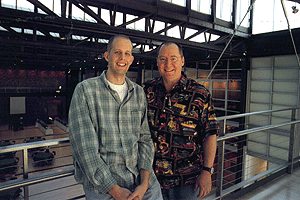 John
Lasseter: The thing is, is if you think about these movies, they take
really about four years to make.
John
Lasseter: The thing is, is if you think about these movies, they take
really about four years to make.
Pete Docter: It's very exhausting.
John Lasseter: Toy Story took four years. We overlapped A Bug's Life by a year, so I jumped onto that and that took a total of four years, but it was overlapped by a year, and then Toy Story 2 was overlapped by two years of that and we started realizing that the goal of the company, Pixar, is to be able to come out with a movie every 12 to 18 months depending on when we want to release the movie, Christmas or summer. So we decided I can't possibly direct all of these movies with them being overlapped that much, so we decided we were going to start getting directors lined up to do their own movies and Pete was sort of the first one. We worked together on Toy Story, came up with a story, co-wrote it together. Pete was the supervising animator on it, where I was the director, so when I went on to A Bug's Life, I had Pete sort of skip A Bug's Life and start thinking about what the next movie was going to be. Then there was this little thing called Toy Story 2 that happened in between there. I don't know if you've even heard of it! In fact the next movie that Pixar is going to be doing is going to be directed by Andrew Stanton; Finding Nemo. That's going to be out 18 months from now as a summer picture for 2003. I'll always be directing my own films, but I wear two hats. I'm executive vice president of creative. I oversee everything creative at the studio on one hand and then I also direct my own films.
Are you surprised at how the technology has changed since Toy Story?
John Lasseter: Excited is more the word, because we're a part of that evolution.
Pete Docter: Really what's happened is that the computer has gotten faster, more powerful and really just enabled us to do more with them. The advances are really more due to the smart people that we have in house, they're able to use this great computing power and come up with things that we would have never been able to do. Five years ago we probably couldn't have done Sullivan's hair in Monsters.
What's the process of making these films?
Pete Docter: The process is more or less this: The story is all important, so we spend two or three years, before we do anything on computers, just drawing and writing. Just coming up with the characters. Once we decide to go ahead and put it into production, we build the characters in the computer, if you think of it as a marionette or a puppet, so it exists three dimensionally in the computer, so from there forward there's no real drawings, it's all within the computer and the puppet, we're able to move it by using various controls, at the elbow is a fairly straight forward, there's just the one control there. Same with the wrist, although generally we'll have forward, back, left, right and twist so three different controls to move, so that way you could do any number of movements like this. And then all the way down. Woody had something like 300 controls, Sullivan I think 500.
What software are you using?
John Lasseter: We have created it. We're fifteen years old this
year and even before that we were the Lucasfilm computer division before
it became a separate company. So we've been pioneering this medium from
the beginning. In fact, our rendering system that we've written, called
Renderman, won an Academy Award this year because it's become the standard
of the industry. In the last ten years, there have been 26 films nominated
for Best Special Effects, 24 of those 26 have used Renderman. Our technology
has really become standard.
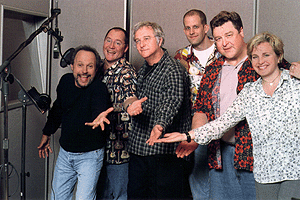
Pete Docter: Really what happens with the technology is that
we want to do this stuff, again, it's all driven by the story, and we don't
have any real way of doing it, so we write some new software that enables
us to do what we need to do tell the story.
Are you software people or creative people?
John Lasseter: It's not that simple. Both of us are trained in animation and art, on that side of it, and the storytelling side, and we work very closely with people who have been trained in computer science. Pixar is the best, best blending of art and technology, yet the line between that is very, very fuzzy. We actually have ongoing education at Pixar University, P.U., and we have classes where we have sculpture, acting, drawing, improv, computer classes. That's why it's amazing to see the artwork being done by the computer science people who have gone through computer science school and start seeing these clay sculptures by them and vice versa. Conversely we're real, real geeks. We are so into the technology. We don't know how to program, but what's important in to be a director in this, is to understand kind of how it works. You don't need to do it, but you need to understand it.
Do you want to take this animation to the photo-realistic level like Final Fantasy?
John Lasseter: It's interesting. Ever since I worked with computer animation, there have been all sorts of people that have always desired and thought that is the goal. For me, the way that we work, is that we use sort of realistic imagery only as something to shoot for. We say that reality is just a convenient measure of complexity. Because if you can create a tool that can produce something that looks almost real then we like to take a step back and produce something the audience knows does not exist, that it's a cartoon, it's caricatured, it's fantasy, it's something, but then use these tools to make that look so believable into the world that we're creating. We want our films, for the audience to look at it, and say, 'I know this isn't real, but it looks so real'. Like Sully, he's walking around, you know he's not real, but look at that fur, bouncing and stuff, and that scene in the snow, I'm still amazed by that, I think that's an incredible thing, with the wind blowing and it's sticking on there and stuff, that's just on a whole other level, but you know that's not real. That's what I think is part of the entertainment value and what we've recognized.
Pete Docter: With the kids, with the humans, and this was the case on Toy Story 2 as well, we always want to make sure that we're doing cartoons. We may be using computers but we're doing caricatured versions of reality. So we're not trying to mimic a real little two-and-a-half-year-old, we're doing a cartoon version of one.
Why no outtakes at the end of the film?
John Lasseter: You are just lucky to have a movie to watch. We were really, really, really under the gun to finish this one.
Can you talk about that, about the hurdles in hitting your deadline?
John Lasseter: The big hurdles, frankly, is the story.
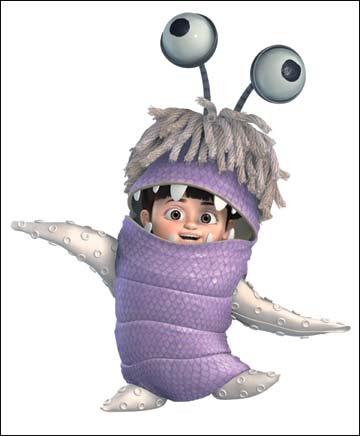 Pete
Docter: The tough thing about the story is you never know when the
idea is going to come, or if it's going to come. You're working on something
and it's just not working, and you keep plugging away at it, and keep plugging
away at it and it's usually until the eleventh hour when you're like, 'Hey,
what about this?'
Pete
Docter: The tough thing about the story is you never know when the
idea is going to come, or if it's going to come. You're working on something
and it's just not working, and you keep plugging away at it, and keep plugging
away at it and it's usually until the eleventh hour when you're like, 'Hey,
what about this?'
John Lasseter: We value the importance of story over absolutely everything else. That kind of drives the producers and the production side a little nuts, because if we get a great idea, even at the eleventh hour, that we think, 'Oh this is going to make it that much better' we will do it and we'll figure out a way to do it.
Did that happen on this?
John Lasseter: Yeah, we don't do many of them, but we really value using previews with regular audiences. Not really what they say afterwards, but audiences are completely honest while they're watching a film. Afterwards is a different story. So we watch the audience watching the movie and we can see whether we've got them or not or whether they're restless or they're there or they're laughing and all those things and we evolved a few things in this. The preview was in spring time, I forget exactly when it was, and we came out of it with a lot of revelations. Then we tweaked it and changed it and we were supposed to be done with animation in June and so we were quickly turning things around. So outtakes. . .
Can you be specific about the things that you tweaked?
John Lasseter: One of the things that we wanted to do, to have at the beginning, is we wanted to take the audience and kids into what they're familiar with about monsters coming out of the closet and scaring. So we were very conscious of like, where are we going to cross the line where something is going to be too scary. In the beginning we milked the tension and it was a little scary and so what we did was after the first preview... you know how it's like really scary, scary, scary, scary and then that monster gets more scared of the kid and steps on the soccer ball and lands on the jacks and all that, so we amped up the humour right after that, that much more to make it funny. And it really works, because kids are starting to watch it, and climb up in their parents lap and all that, and then all of a sudden, when he starts becoming a goofball, they're like laughing and in hysterics and all that. It really worked.
The little bird short that precedes Monsters, is that going to be in theatres?
John Lasseter: Yes, and we're proud to say that. For The Birds.
Pete Docter: It was directed by Ralph Eccleston who was the production designer on Toy Story.
Did you make that for the Academy Award consideration?
John Lasseter: That's not why we do it. The short films, we really love short films. That's where Pete and I got our start. We love them as an art form and they don't get enough play in the world. We produce them for two reasons; one, it is a great way for us to try out new technology, because sometimes when you're trying something, some new piece of software technology, it's very labour intensive to use. You can't have that on a feature film, but you can have it on a short, so we try out new things. For instance, in Gerry's Game, the chess player, it was the first time we had clothing that was dynamically animated. Meaning, the computer was animating the clothing based on the underlying structure of the body, it's the way clothing works on us. So you look at Boo, running around, her clothes, it's like that. It was kind of derived from that. In For The Birds, two computer objects don't know where the other one is, so if they move, they move right through each other. And so in this case, one of the things we worked on is when they get smashed together, they sort of know where each other is.
What about including more Toy Story jokes in Monsters?
Pete Docter: We talked about that. I think if you go too far, you pop people out of the film and you want to keep them believing in this world.
Lasseter: But we absolutely love putting those kinds of funny
self referencing jokes in there.

What about the role in Apple in all of this?
John Lasseter: Steve Jobs is our CEO and he's CEO of Apple, so there's a connection there, but that's just a person. The companies actually have no real affiliation, except that we use Apple computers throughout the company for email and word process, you know, and Apples are getting faster and faster and their new OS10 is Unix based which is all of our software is Unix based, but as yet we haven't transferred any of our software that creates the movie over to Apples.
How did you make Boo such a fully realized character with only a three word vocabulary?
Pete Docter: With Boo, we knew early on that we wanted this really appealing little kid, so as part of the process, we make a temporary version of reels. We do the voices ourselves, we do temporary music and stuff, just to see whether the whole thing is working or not. What we did was, we initially started doing the voices ourselves for Boo, and it just popped you out of the film to have an adult voice. So, one of the story guys, Rob Gibbs, had a two-and-a-half-year-old daughter and we brought her in and she initially we were going to record her just doing the lines. I'd say, 'Okay, now pretend you're really scared.' And she would just go and run away and play and it was just really hard to get her to stand there. So we ended up picking up the mic and following her and we just played. We had toys, we had puppets and we just fooled around. We got her to say kitty and a couple of other things, but the rest of all the vocalizations were just real noises that she made.
John Lasseter: When she was young, when she first started, her
language, you couldn't really tell. Only her parents knew what she was
saying. But as she got older, she started speaking English to the point
where the editors would go back and turn it back into nonsense.
February 2002 interview by AICN.
Among others things, Monsters Inc. says that a laugh is worth more than a tear. It’s kind of an opposite message to what other nowadays animation films like Shrek or Nightmare Before Christmas which are darker or irreverant in their message...
Pete Docter: We thought it was important, giving the subject of monsters, not being too dark and moody and gloomy. That’s central to the whole idea of the film, that you may think of this guys as nasty one but they just work at a factory, fill up paper work, clock in and clock out, talk about union dues, just like my dad did. These guy are not what they appeared.
Is it also a way to avoid cynicism, as opposed to Shrek, which is a cynical movie?
Pete Docter: I think so. It probably reflects the way we thought about the world in Pixar, less cynical. We’re thankfully away from Hollywood, we can avoid its rules, and have fun. That shows in the film : we’re having a good time. We generally believe life is a positive experience, with great joy in there.
Quite all the Pixar films introduce an human character, and they’re more and more present, but purposedly not designed on a realistic point of view
Pete Docter: We made a very conscious decision even way back on toy story that we’re not gonna try or catch reality. Our goal is not to do a photorealistic human to put actors out of work : we’re doing cartoons, making films with characters who could be believable and accepted by audience.
This subject matter kind of lead us to wherever we go. Most of the time we’re interesting in teling stories conected to our world but one step away, trying to representing familiar thing but with a twist, giving new way. That’s why toys come to life and monsters can be in a closet. On the other way, computer animation is kind of half way between 2D animation and live action. So we really get the best of both : the color and fantasy design from 2D and cinematography, lightning from live action. Our choices of character design quite releflects that. A lot of times, the shapes are very simplified, some of the textures are more real. There’s no way you could look at Boo and find she’s a photography of a real kid, it’s obviously a cartoon. We’re very aware of that, it’s a conscious choice. There’s nothing really interesting to me about trying to replicate reality. To me a Hirschfield character is way more interesting, it captures even more the essence of someone than a photograph would. We’re trying to do the same thing with the characters in our movies, by trying to capture the essence of a movement, a gesture. That’s a strength of animation, so we try to take advantage of that.
I guess you heard about this project of film using the face of Bruce Lee’s. What do you think of it?
Pete Docter: Ultimately it seems kind of doomed to me. Nobody except that one particular actor would be able to make the choices, that’s what makes everyone unique. You could animate him, maybe make him look convincing but the real guy did it and it’s never gonna have the essence of what makes people go to the movies : actors bringing characters to life on the screen.
How difficult was it to find the right look, the right design for the right character?
Pete Docter: One of the most difficult parts of the work, was early on, once we wrote the treatment, those 12-14 pages document that told the story, I gave that to a bunch of artists, and said : design these characters, I don’t wanna give you any visual inplug. They came back with many and very different visuals sketches. We just ask : how can we use that stuff and in what way. We decide to use a kind combination of real life texture : Sullivan has essentially the fur from a bear, his horns are impala’s. Mike’s skin is like a south american tree frog. We coupled this natural texture with the child like coloring : Sullivan’s blue with purple spots, something that can’t never really exists. The result is the marriage of those two.
Was there a step you couldn’t go beyond creating monsters because it could have been really scary for kids ? Did you reject some design because it was too scary ?
Pete Docter: We were very conscious of that. Particularly that Sullivan needs to be believable as a monster : he needs to have horns and sharped teeth but not so scary that you don’t wanna watch it for one hour and half. He must be appealing and that you enjoy look at him. I can’t remember about something we really have to tone down. The basic concept meant that within a world of monsters, nothing is really too scary, it’s all in relation the kids. You’ll never know how the things will be received, when we first came up with the film, the first version screened one year ago, it opened with a child in bed, moonlight, something spooky going on, enter the monster, the kid sees it, raise and scream and the lights come out to show it was fake. It seemed to be a cool, clever way to introduce and let the audience familiarize with the film. But it was perceived as a very spooky movie, for ten minutes after this opening, nobody was laughing, even at stuff we knew was funny, but we weren’t giving them permission to laugh. So when we saw that in the screening, we went " oops, how to fix that? ". Then came the idea of the title sequence, very poppy and fun, that would telle the audience : this is gonna be fun, this is gonna be a comedy, a lighthearted, fun film. Ultimately it improved the film by showing that the monsters clearly are afraid of children, which is the central idea of the film.
On this film, John Goodman gives a very strong performance. You can’t dissociate Sullivan from his voice. How do you care of all the foreign dubbings?
Pete Docter: We’re not able to check each version. We have to trust the dubbing people in other countries. Not only for the language, I don’t speak french or one one of the thirty-five other languages Monster’s inc is dubbed in. Generally they’ve done a very good job so far. It’s important for kids for any country to understand what they’re saying. . You’re right, the characters become so much a part of the voice talents and vice-versa. I was in a press screening in L.A. I saw John Goodman goin’ " hey Pete, howyadoin? " I first thought " hey, it’s Sullivan’s voice "ŠThe characters really come to life in your brain. You start to think : Mike wouldn’t say this, he would use these words or phrase it this way. It’s kind of cool, because of course, that’s the goal : create believable characters.
When Mike has to make Boo laugh, he tries with adult gags, like this standup comedy talk, but he has to go back to gag for kids to succeed. Is it a way you’ll always have to go back to kids?
Pete Docter: Yeah. There’s a lot of that in the film: lots of jokes for kids and other for adults. We’re trying to make films for anybody : teenagers are 40% of our audience. Because of the many layers of what’s on the screen. I went see the film in theaters, looking at the audience while they were wathcing the film. You can hear different laughs, tell them from kids ones when there’s physical comedy, and adults’ when there’s intellectual jokes.
This is your first feature effort directing. It happens when Pixar’s leadership in CGI animation is threatened by other companies. Did you feel any responsibilities?
Pete Docter: I was lucky enough to already be there on Toy Story. I really watched John Lasseter through the all process. I’ve also directed some shorts filmsand commercials on my own. So I kind of have a sense of how the whole process works. It’s really a group effort, the whole thing is a group of people working together creating the stories. I’ve had a lot of help but it was indeed stressful a lot of times but it was a lot of fun too. Pixar has such great, talented peoples; amazing painters, computer technicians, all working together to create these films.
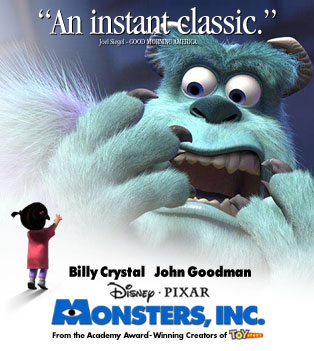 At
the end of the movie, the industry must move to another kind of work find
a new life. Is it some kind of message to Disney, like, " your age is over,
time to go on something else"?
At
the end of the movie, the industry must move to another kind of work find
a new life. Is it some kind of message to Disney, like, " your age is over,
time to go on something else"?
Pete Docter: (Laughs) No. It’s something John is very strong on it, and I think he’s right : the audience is not gonna feel good if leaving this film knowing the monsters are scaring kids. It’s just more kind of practical thing. We want to feel good that Sullivan has changed the world in some way, through his experience with this kid, he now can’t go back and stand scaring kids again. He needed to find some way of reinventing the way the world worked.
All Pixar’s film are about a individual confronting with the outside world. Is it on purpose?
Pete Docter: Films are really about struggle. The characters need to change something. There’s three things he can struggle against : himself, another character or the world he’s dealing with. In most of our films, we try to make him struggle with all threes.
What the world gets you is a sense that it goes beyond just a personal change. On a very basic level, what we’re trying to do in every Pixar film is create characters who are interesting, that the audience cares about and then we watch’em grow and change in this film it’s Sullivan. At the beginning, all world is about his job, he’s the top scarer, he wants to be the best and that’s all that matters. When he’s stuck with this kid who he can’t stand, she eventually changes his life to the point he can’t go back to his previous life. We could have stop the film there but It feels like it has more sense to involve the world in some ways that as a result of this personal struggle, maybe that’s a sort of western prejudice that one person could change the world, and that’s something we really believe in, so this one person change and struggle has an effect on the society he lives in.
There’s also always some kind of manual work done by the characters in Pixar’s film, is that something conscious?
Pete Docter: In order to take what they want, our characters has to take some physical action. The fact that they’re building something manually is a good way to show, to demonstrate that they haven’t accomplished their goal yet.
Is it wrong to say that the door chase in Monsters Inc. is an hommage to the train chase in Aardman’s The wrong trousers?
Pete Docter: There’s some of that. It’s a lot of elements put together. It came from the concept that once we put the idea that monsters gain access to the kid’s room by this doors, they must be stored somewhere. I wanted to go where all these doors go. Then, we looked a lot of chase sequences : the wrong trousers’ one, Indiana jones & temple of doom’s oneS What makes our scene unique is not only it is a rollercoaster highspeed thing but that it leads the characters anywhere in the world with all these doors.
From Will Coyote cartoons to this film or Wallace & Gromit films, there’s always machines in it. Machines seem to fascinate animated movie directors, why?
Pete Docter: They’re fascinating in they’re also a product of the characters that use them. Very early on, there might be a link between the rythm the machines have and animation. Animation is very temperal, very closey related to music. Machines creates a kind of visual rythm.
What are for you the main differences between an animated movie director and a live action one?
Pete Docter: They’re really kind of the same job : at the end, your job is to make an engaging film that hopefully gets the people emotionnal heart. In animation you’re doing this one little pice at a time, the director is the only guy who knows what it’s gonna look like together. With live action, most of the time, you’re on the set, with all the crew workin’on the same time. I guess it’s close to theater direction. I’ve never directed live action, but that’s my perception of it. In animation, you have to be a little more like a scientist in some ways. To get a good concept and then to be able to break it down into pieces, section it all and know how it’s gonna fit back together. It’s kind of tricky.
You Pixar’s guys seem to exchange the tasks for each film...
Pete Docter: It’s just the way it’s worked out. I really don’t know why. I guess it keeps things fresh, kind of like in the Talking Heads band, they were all always switching instruments You get different ideas and point of views that way. The director, me in this case, is essentially the person that does everything from story to directing the talent animating, designers The co-directors are specialized in special areas, David Silverman work particulary on story and deal with problems in it. I check back at the end. By studying at Calarts, I learned a lot about computer animation but not much about staging or composition all theses rules of cinematography
Would you say that in a way your work is about to keep playing with toys?
Pete Docter: Yeah (laughs). It’s a good job. We could go some toy store with the company credit cards For this film we had to visit a lot of factories. I loved factories as a kid, it’s kind of similar things now : you just got to keep experiencing the things you really love. The excuse is : well, we’re making a movie, so it’s research
Nowadays two differents use of animation are becoming more and more popular : Japanimation and Videogames. What’s your feeling towards those?
Pete Docter: I’m kind of clueless to the videogames. I like the old ones like Tempest or Pac man. Anyway I guess it’s really important that they used real scripts, that even in a game human experience wants some progression that’s not just shooting’em up, wants sort of development and complication, it makes sense. Anime is giving a lot of people more and more inspiration. Like seven or eight years ago, there were people within LA that were discovering it and realizing how far advanced it was, more than what was going in Hollywood, that they were using innovative camera angles and techniques and telling stories that wre much further beyond what was being done in Hollywood. Miyazaki was one great inspiration for Monsters inc.
As a director, do you feel there’s anything really monstruous about kids?
Pete Docter: They definitely could be scary, especially teenagers.
We tried in this film to represent the whole picture of kids. My own daughter
is three. She can go from this sweet little angel to devil in a blink of
an eye. We wanted to show all sides of a child. One of the fault of many
animated films with children is that in there, everything is nice and sweet
and cute. It’s funny that in a monsters film the character we were the
most afraid of was a little girl. No one knows how a monsters looks or
moves or react, but we all know how a child do.
 |
 |
By Barbara Robertson, Senior Editor, West Coast, for Computer
Graphics World - October, 2001
If you didn't suspect, when you were a child, that a monster might be in your closet, you probably knew someone who did. But did you ever ask why a monster would be there? When Pete Docter asked the question, his answers put him on a path that led to a feature film. Monsters, Inc. marks the directorial debut for Docter, who was supervising animator and one of four screenwriters for the enormously successful Toy Story, Pixar's first full-length film.
With Toy Story, Pixar crafted a new feature film genre, and with each film since-A Bug's Life, Toy Story 2-the studio has pushed the art and technology of computer animation further. This film is no exception. The studio gave three of the country's leading experts in dynamic simulation, all of whom work for Pixar, two of the hardest problems in computer graphics: simulating hair and cloth. The Monsters, Inc. production team also devised innovative techniques for creating more visual complexity than in previous films, and mastered some tricky rendering problems. All these advances in technology and technique were needed to serve the story. The main characters required hair and cloth simulations; the other techniques helped make the monsters' world believable.
That world began to take shape as Docter and his colleagues at Pixar thought about why those monsters are in the closet.
"We figured out that the monsters scare kids because that's their job. That's what they're paid to do," Docter says. Why? The monsters' world is powered by screams. "What the monsters do is go into a kid's room, harvest the scream, and then refine it into high- or low-octave scream for commercial- or industrial-grade use," explains Docter.
The two stars of the film, James P. Sullivan (voiced by John Goodman)
and Mike Wazow ski (Billy Crystal) work for one of the big three energy
companies, Monsters Incorporated. "Sully" is the company's best scarer;
Mike is his assistant, best friend, and roommate.
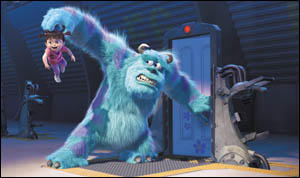
"The way it works is that there's a big vault that houses millions
and millions of kids' closet doors that can be anywhere in the world-Paris,
Rome, Detroit," says Docter "It's all computerized. You get the kid's card
and swipe it through a console like you're paying for groceries. The computer
accesses the door, and it's brought up on what looks like a dry-cleaner
track. The door mechanism grabs it, the computer activates it, and the
monster goes in and scares the kid."
There's a big problem, though. "Times are tough for the energy companies," says Docter. "These days, kids are not as easily scared because of video games and the media, so there's an energy crisis."
One day a human child follows Sully into the monster world, where children are forbidden: The monsters believe kids are dangerous because they contain so much pure energy. And indeed, hiding the cute bundle of pure energy is difficult. "When she gets loud, light bulbs pop, and all kinds of things go haywire," says Darla Anderson, producer. But with Mike's help, Sully tries to send the little girl, whom he's named Boo, safely home before she's discovered. In so doing, he crosses paths with a jealous co-worker and stumbles upon a dastardly plot to boost energy production. And the plot thickens.
All told, the crew created 50 monsters plus variations and 22 different location sets, including kids' bedrooms, Harry Hausen's Sushi restaurant, the snowy home of the Yeti, the scream extraction factory, and the city of Monstropolis itself, where buildings are decorated with eyeballs and claws rather than flowers and vines. One of the most complex sets is the door vault inside the factory, which has 5.7 million unique closet doors, of which around 500,000 are on a mile-long "highway."
"It's probably the most complicated in terms of renderability," says Anderson, who notes that individual frames in some establishing shots, which have numerous moving doors and use atmospheric effects to emphasize the door vault's cavernous space, could take as long as 80 hours to render. That's a measure of the complexity of this film given today's processors-and Pixar has a ton of them: The studio's renderfarm now contains 3500 Sun Microsystems processors.
To measure and compare the compute power needed for its films over the years, Pixar uses so-called "RenderMarks." (To calculate how many RenderMarks a particular machine has, Pixar runs a predefined set of images through RenderMan and measures how long it takes to render frames. A 1000 RenderMark CPU computes the same frame twice as fast as a 500 RenderMark CPU.) The first Toy Story (1995) used 50,000 RenderMarks for rendering; A Bug's Life (1998) needed 700,000 RenderMarks; and Toy Story 2 (1999) took 1.1 million. Monsters, Inc. re quired 2.5 million Render Marks, more than the first three films combined.
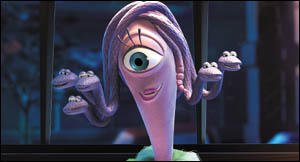 The big
jump for Monsters, Inc. is due in part to Sully's hair and Boo's T-shirt.
Some 2,320,413 hairs cover Sully's purple-spotted, eight-foot-tall body,
all dynamically simulated using new technology developed for this film.
Also simulated is Boo's oversize T-shirt, which hangs loosely on her 2-1/2
foot tall body. The two stars appear in hundreds of shots.
The big
jump for Monsters, Inc. is due in part to Sully's hair and Boo's T-shirt.
Some 2,320,413 hairs cover Sully's purple-spotted, eight-foot-tall body,
all dynamically simulated using new technology developed for this film.
Also simulated is Boo's oversize T-shirt, which hangs loosely on her 2-1/2
foot tall body. The two stars appear in hundreds of shots.
The launching point for the new technology was a cloth simulation system created by senior scientist Michael Kass for Pixar's Oscar-winning short film Geri's Game (1997). Senior scientists Andy Witkin and David Baraff began working on the code base for the new simulator in 1998.
This simulator, named Fizt, is the result of a long-time collaboration among the three scientists: Kass and Wit kin began publishing papers together on physically based modeling 15 years ago. Witkin and Baraff began working on cloth simulation at Carnegie Mellon University in 1992 and while there developed Maya Cloth for Ali as|Wavefront. "There were things [in the Geri's Game and Maya Cloth systems] that were the best we could do at the time, but frankly, they weren't good enough for what we needed to do for Monsters," says Baraff.
"We needed a solution that was robust enough to work in a production environment for a film in which fur and clothing appear in many of the shots," says Witkin. "Things had to work with little human intervention, and the simulation couldn't grind our pipeline to a halt."
Thus, Witkin and Baraff began developing a system that could model a variety of dynamic effects, with emphasis on hair and cloth. "Hair and cloth have a common foundation," says Witkin, explaining, for example, that both hair and woven threads are easy to bend and resist stretching. In addition, both can be broken into small pieces-hair can be represented as a curve that can be broken into a chain of particles; a thin sheet of cloth can be broken into particles or triangles. "You can find common ground by saying that ultimately everything in the simulator is going to be approximated as a bunch of particles. Then you can model the dynamics of the particles and the forces that interact and couple them."
"What's different is that the interaction forces are more complicated with clothing because you have things happening in two directions and because the problems due to collision and contact are more complicated," Witkin says.
The two biggest issues, according to Baraff, were cloth-to-cloth and cloth-to-solid collisions. In cloth-to-cloth collisions, the cloth wrinkles and folds on itself. "Picture what happens when you crumple a piece of cloth into a ball," says Witkin. "[The simulated cloth] has to keep from passing through itself." Cloth-to-solid collisions happen when cloth is draped on the human body. In this case, the challenging problems happen when cloth is draped on a character's body and gets sandwiched between two body parts. This typically happens in armpits and elbows and when animators place a character's arm next to its side. "The cloth goes inside the body and even intersects itself yet somehow you expect that when you move the arm, the cloth will magically settle back into a nice clean state," says Baraff. The problem is similar for Sully's fur. When his arms are tightly at his side, for example, his arm hair bunches and intersects with his body hair.
"If you don't know how to stay out of that situation or get out of it
once you get into it, you can wind up with the cloth getting tangled in
a way that's physically unrealistic and you can't find your way out. It
grinds the simulator to a halt. Someone has to come in, iron out the wrinkles
[or comb the hair] and start over. Even if that happens only from time
to time, it can be a serious problem for the flow of production," says
Witkin. Worse, because animators move only the body parts visible to the
camera, body parts hidden from view often end up in strange and physically
impossible positions-an animator might let an arm poke through a leg, for
example.
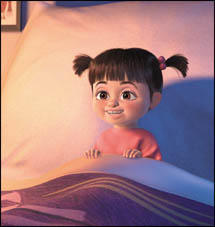
"It's an exceedingly difficult problem, but we thought we knew how
to solve it coming in," says Baraff. Their idea was to have the animators
avoid creating these problems. "The word we got back rather quickly was,
'No. The animators will continue to do what they have always done. You
will find a way to make the simulator work correctly in the presence of
that,'" he says.
They solved the problem by creating a physically based simulator that was tolerant of physically unrealistic behavior. The simulator knows how to keep tangles and interpenetrations from happening for the most part, but if they should happen, it can repair the cloth (or hair) and put it back into the expected shape. Thus, because interpenetrations can happen for a short time in a relatively small place, animators usually did not have to change the way they worked. Simulation and effects sequence supervisor Mark Henne, who helped turn the simulation technology into a viable tool for cloth dynamics, says, "We had to send the cloth simulation back to animators because of intersections in only about 10 percent of the cases."
Thus, although simulation added a step to the pipeline, the process didn't create a bottleneck. In addition, the scientists accelerated the simulation by using such techniques as multithreading. They cite 17 minutes per animation second (24 frames) of output for cloth simulation, and 10 minutes per second for Sully's hair. Pixar won't reveal details about the solution other than to say it involves "analyzing the geometry of the way the cloth is intersecting itself." The studio has filed for patents on the technology, and the scientists expect to publish technical papers describing the process next year.
Sure Shots
As did Henne for cloth simulation, simulation and effects sequence
supervisors Michael Fong and Steven May brought hair simulation into the
production process. They put Sully through obstacle courses to test the
simulator, created tools, methods, and shaders for growing, grooming, and
rendering the hair, and even created "wind widgets" for specific situations.
For example, the underlying engine for growing hair is a RenderMan DSO
(dynamically shared object) written by May that distributes hair on the
character, reads data from the simulator, and then runs a shader called
a "builder" for every hair. "The builder has information about each hair-its
length, taper, color, and other characteristics that make it unique." And
Fong wrote an interactive 3D grooming tool for the 28,000 "key hairs" that
are procedurally distributed on all the vertices on Sully's model.
Because simulation added another process to the production pipeline, Pixar created a new "shots" department under the direction of Galyn Susman, simulation and effects supervisor. Susman explains, "We're the catch-all, can-do-it department. Once a shot leaves layout and goes to animation, we assign a shot TD [technical director] to it. The shot TDs are responsible for simulation, effects, and rendering passes. They also help lighting supervisors and optimize rendering." Shot TDs, for example, built collision objects used by the simulator and created atmospheric effects. They put animated scenes onto video monitors for shots within shots and created 3D matte paintings that provide a quick glimpse of what's behind a closet door. And they created other types of effects.
"Some things don't fall easily into typical categories, but a lot of what we do is make the characters feel like they are stitched into their environment," Susman says. "We put footprints in the snow, or make a soft cushion respond to a character's touch."
While most people in production use Pixar's proprietary software, Susman's group uses "anything and everything we can get," she says, listing, in addition to Pixar's internal tools, Nothing Real's Shake, Ado be Systems' After Effects, and Inter active Effects' Amazon Paint. "And we use Maya a ton. We do all our particle work in Maya." Alias|Wavefront's Maya is also used to create models at Pixar.
In addition, the shots department is responsible for final rendering. Tom Porter, supervising technical director, explains, "We used to have a rendering group at the tail end of the process and by the time the shots got there they could be huge. Now, the shot TD is responsible for the shot as it moves through the pipeline."
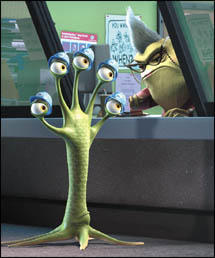 One
rendering problem in particular was posed by Sully's hair. "We got tremendous
help from the RenderMan team," says Rick Sayre, shading supervisor. "They
completely rewrote the way hair is rendered and made it a lot faster and
more efficient." For example, a team led by Render Man engineer Craig Kolb
devised new algorithms to reduce the number of micropolygons generated
for each hair and to use parallel processing for the hair shading. Another
"hair" challenge involved lighting and shading. "The way hair responds
to light is intimately tied with shadows. If hair doesn't have self-shadows
on it, it doesn't look right," Sayre explains. "And the way we work is
to think of shadows as a conscious choice. They don't just happen." But
Render Man's shadow maps, which are basically on or off-something is in
shadow or it's not-didn't produce the effect they wanted. The shading team
also discovered that classical hair illumination models, even if mathematically
sound, don't look right. Instead, they used an algorithm called Deep Shadows
developed by Tom Lokovic, based on research published in the paper, "Deep
Shadow Maps" by Lokovic and Eric Veach, Pixar RenderMan engineers, in the
Siggraph 2000 Proceedings. With Deep Shadows, they were able to self-shadow
the hair using colored shadows with transparency, and were able to have
motion blurred objects cast shadows. "One of the best uses for Deep Shadows
is for hair," says Dan McCoy, shading technical director.
One
rendering problem in particular was posed by Sully's hair. "We got tremendous
help from the RenderMan team," says Rick Sayre, shading supervisor. "They
completely rewrote the way hair is rendered and made it a lot faster and
more efficient." For example, a team led by Render Man engineer Craig Kolb
devised new algorithms to reduce the number of micropolygons generated
for each hair and to use parallel processing for the hair shading. Another
"hair" challenge involved lighting and shading. "The way hair responds
to light is intimately tied with shadows. If hair doesn't have self-shadows
on it, it doesn't look right," Sayre explains. "And the way we work is
to think of shadows as a conscious choice. They don't just happen." But
Render Man's shadow maps, which are basically on or off-something is in
shadow or it's not-didn't produce the effect they wanted. The shading team
also discovered that classical hair illumination models, even if mathematically
sound, don't look right. Instead, they used an algorithm called Deep Shadows
developed by Tom Lokovic, based on research published in the paper, "Deep
Shadow Maps" by Lokovic and Eric Veach, Pixar RenderMan engineers, in the
Siggraph 2000 Proceedings. With Deep Shadows, they were able to self-shadow
the hair using colored shadows with transparency, and were able to have
motion blurred objects cast shadows. "One of the best uses for Deep Shadows
is for hair," says Dan McCoy, shading technical director.
Screamy Weather
The shadowing technique was also used for the fog, steam, and atmospheric
effects that occur in Monstropolis, because screams look a bit like steam.
To help shot TDs and lighting supervisors work easily with these effects,
the shading team created little programs, DSOs, which could be linked to
the renderer. "You could have a foggy sphere, a foggy box, a volume of
fog in the room, or little puffy fog stickers," says Sayre. "For example,
light beams shining through particulate matter in fog helped give the door
vault greater depth.You can treat fog as a first-class object, put lights
on fog or not, and use different intensities in the shadows for fogs."
Another consequence of being powered by steam is that there are steam-carrying pipes everywhere. To create this network, the modeling department made a construction kit of pipes and connectors that the set-dressing department could put together. Tony Apodaca, who worked on production shading for Monsters, Inc., created an intelligent shader that worked with the construction kit. "The shader would know where it was in space, so it made the pipe a little corroded at junctions, and scratched the pipe based on how big it was," says Sayre.
 This
is the first time the shading team worked as closely with set dressing
as with lighting, where final touches are added to a model's surface. For
this film, the shading department helped make lighting easier and also
gave lights a new purpose."The way we light is very close to painting,"
says Jean-Claude Kalache, supervising lighting lead. "We look at a corner
and think we need a highlight or small shadow and then step back and look
at our work." Thus, an average shot in Monsters, Inc. had 200 lights.
This
is the first time the shading team worked as closely with set dressing
as with lighting, where final touches are added to a model's surface. For
this film, the shading department helped make lighting easier and also
gave lights a new purpose."The way we light is very close to painting,"
says Jean-Claude Kalache, supervising lighting lead. "We look at a corner
and think we need a highlight or small shadow and then step back and look
at our work." Thus, an average shot in Monsters, Inc. had 200 lights.
To help make the hard problem of lighting Sully's hair easier, the shading department gave the lighting team tools that allowed them to accurately light the furry monster by lighting only his skin, which allowed the process to go much faster than if his hair had to be visible. And, with clever "coco" (color correction) lights developed in the shading department, the lighting team could "paint" monster models with colored lights to create the visually complex illusion of hundreds of unique monsters in the background.
All Dressed Up
The artists in the set-dressing department gave the film much of its
most obvious visual complexity, however. "Essentially, when a set comes
to us from the modeling department, it's just walls and windows," says
Sophie Vincelette, supervising set dresser. To help set dressers turn bare
rooms into complex stage sets, the modeling department provided an electronic
catalog with hundreds of 3D props-everything they could imagine would be
needed in a real world-paper, pencil, computer, desk, chair, and so forth
for factory offices; a manhole cover, litter, lights, and other accoutrements
for streets; a poster, book, magazine, and toys for kids' rooms, and so
forth. The shading department then created textures and shaders and gave
set dressers controls they could use to vary the look of models. "They
could order Burp cola, number seven, slightly scratched, from the catalog,"
says Sayre.
The set dressers often took their cues from the story. Take Mike's desk, for example. "They're always saying to Mike in the movie, 'Don't forget to file your paperwork,' so we wanted to make it look like he doesn't file his paperwork," says Vincelette. They piled folders of papers on his desk, and on the floor around the desk if it were late in the day, using the shader variants to bend and fold the paper, and to change colors and texture maps.
The set dressers also helped give the city its late '50s look. "We try
to put history in the worlds we create," says John Lasseter, executive
producer. "Not only do we do a back story of each character, we do a back
story of the buildings." The back story in this case is that Monstropolis's
big growth happened in the late '50s, when the baby boomers were still
young, naive, and easily scared.
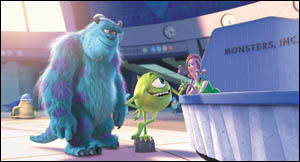
This attention to detail and to creating visual complexity permeates
the film. "As a director, you work really hard to make the audience suspend
their disbelief," says Lasseter, who directed Pixar's previous features.
"You take them into a world where they are just with you. If any visual
thing happens that doesn't seem right, boom, you've lost them for a few
seconds."
Adds Ed Catmull, Pixar founder and president: "From a technical point of view, I think we're getting closer to the point in our films where you don't notice the technology. If people pay attention to the effects when they watch our films, then we haven't done our job. But, for example, if the hair looks so good that you don't think about it because it feels like a natural part of the character, then we will have succeeded. If movement is too simple, then it stands out. We've become more complex in order not to be noticed."
What will be next, then, for the studio in terms of technology?
"It used to be barely possible to make these films," says Catmull. "Now
the difficult challenge is to make it easy."
DESCRIPTION OF A DELETED SCENE
From the July 10, 2003 edition of "Why For"
published by Jim Hill at JimHillMedia.com
Would you like to see and read a full-blown sequence from this Pixar animated feature that got cut out the film very late in the game? Something that didn't even turn up on the "Monsters, Inc." 2-disc DVD? Then go pick up a copy of "Boo on the Loose" (January 2002, Random House).
I'm not kidding, people. This $3.99 softcover children's book -- from Random House's "Step into Reading" series -- is actually based on a sequence that was originally supposed to have been in "Monsters, Inc." This sequence was reportedly fully developed, ready to go into animation. But it was eventually cut from the film because ... well ... to be honest, the scene really doesn't portray Mike and Sully in a very sympathetic manner.
To explain: this sequence would have supposedly come in the film right after Boo falls asleep in Mike's bed. Now -- as you'll remember -- the two monsters are absolutely desperate to get the little girl out of their apartment. For fear that -- should the Child Detection Agency ever find out that they've been harboring a toxic human child -- they'll be banished forever to the human world.
Which is why Mike formulates eventually this simple if somewhat cruel plan: the next morning, he and Sully will lure Boo down into Mike's car. They'll then drive out into the countryside, leave Boo there and ... voila! Problem solved.
Well, the next morning, things (of course) don't go quite as smoothly as Mike had planned. By that I mean, he and Sully do get Boo (who's now disguised as a baby monster, so as not to arouse suspicion among the neighbors) downstairs and into the car all right. They do also manage to drive out to the country, to a remote park on the outermost edge of Monstropolis, without things going awry. It's only when Mike and Sully try to get the toddler out of the car that their carefully crafted plan immediately falls apart.
What goes wrong? Well -- for starters -- the moment that Sully and Mike exit the car, Boo leans on the "Auto Lock" button in the back seat. Which instantly locks the two monsters out of the car. Looking in through the windows, Mike and Sully plead with the little girl to hit the "Auto Lock" button again and re-open the car's doors. Boo just smiles and waves out at the two monsters.
So Mike and Sully quickly confer. They then decide that the only way that they'll be able to lure the little girl out of the car is by pretending to have fun. So much fun that Boo will have no choice but to open the door to come outside and join them. So -- using a few items that they scavenge out of the trunk -- the two monsters put on an awesome display of pretend fun by:
- Having Sully jam Mike inside of a spare tire and then rolling him
down a hill.
- Sully seats Mike on top of the car's jack, and then -- using the
jack handle -- pumps the one eyed little green monster up-and-down, up-and-down
... as if Mike's on some ride at the carnival.
- Then -- running out of props -- Sully just grabs Mike by the arms
and spins him repeatedly in a circle, saying "Wheee! Doesn't this look
like fun? Don't you want to play, Boo?"
But Boo doesn't budge. She just sits happily in the back seat, playing with Little Mikey (Mike's teddy bear).
Things look pretty bleak for Mike and Sully. Until a monster butterfly flutters by the car window. Instantly intrigued by the colorful insect, Boo quickly opens the car door and chases after the butterfly as it flutters across the park. Soon both Boo and the butterfly disappear into the brush at the edge of the park.
"Now's our chance!" says Mike. The little green monster leaps the car and urges his large friend to join him. Unfortunately for Mike, Sully's clearly having second thoughts. The blue big monster's really reluctant to get in the car and just drive off, abandoning Boo. Much as he'd hate to admit it, Monsters, Inc. 's top scarer has developed some feelings for the little girl.
Still -- at Mike's urging -- Sully does eventually get in the car. And the two monsters do actually try to drive off and leave Boo. But they can't.
"Why can't they leave?" you ask. Not because Mike and Sully have a change of heart. But rather, because Mike's car is now out of gas.
The two monsters sit there for a moment, wondering what they should do. Then Sully gets an idea! If he goes out into the woods and find Boo, then brings the little girl back to the car and gets to her to scream ... well, Boo's scream would hopefully be enough to fill up Mike's fuel tank. Which would then allow the two monsters to make their escape.
So -- grabbing Mike's teddy bear out of the backseat -- Sully heads off for the woods at the edge of the park. He then calls and calls for the little girl, eventually growing worried that Boo may have become lost or injured or attacked by some animal when ...
WHAM! Boo comes scrambling out of the underbrush. Clearly delighted to see "Kitty" again, she rushes right up to the big blue monster and hugs him around the leg. Sully is relieved to see that the little girl's okay ... then obviously puzzled as to why he's not having any sort of toxic reaction from being in this close a contact with a human child.
Meanwhile, Mike's waiting nervously inside the car. He looks through the windshield and sees ... Sully walking out of the woods, holding Boo's hand. "You're holding its hand," the green monster says with horror. "I know," replies Sullivan. "I feel okay, though."
Sully puts Boo back in the back seat of the car. Mike now urges the big blue monster to make the cute little toddler scream (so that she can fill up the car's gas tank). So Sully turns around and sees this trusting little girl smiling up at him ... and just can't bring himself to frighten Boo.
"Come on! Just scare it! Now!" says Mike. But James P. Sullivan won't. Which is why -- in frustration -- Mike Wyznowski slams his head down on the car's steering column. Which causes the car horn to honk. Which somehow startles Mike in a very comical way. Mike's reaction causes Boo to laugh ...
Which causes the car's engine to suddenly roar to life. Mike and Sully exchanged startled looks, as if to say "How the hell did that happen?"
Mike looks back at Boo, then over at Sully. "Okay," Wyznowksi says. "She can stay ... for now."
But -- as the two monsters drive back toward Monstropolis and the little girl snuggles down into the back seat, hugging Little Mikey as she falls asleep -- the little green monster mutters "But just remember ... that's my bear."
That's a great scene, isn't it? Loaded with heart and humor. So why did the guys at Pixar eventually cut it?
Well -- as I mentioned at the start of this "Why For" answer -- this proposed sequence didn't exactly put Mike and Sully in a very good light. I mean, here were the two leading monsters in the movie, getting ready to abandon a cute little girl in the wilderness. Leaving poor Boo to fend for herself. Doing something like was an awful easy way to make the audience really dislike Mike and Sully.
Finally recognizing the risks involved with inserting this scene in the movie, the "Monsters, Inc." story team -- after literally spending months developing this particular sequence -- opted to drop it. Deciding that it might be smarter in the long run to go another way. Create some other sort of scene that would cover the same ground, story-wise, but not make Mike and Sully seem so unsympathetic to movie-goers. Not make these two guys seem like such heartless ... well ... monsters.
So the storyboards for the "Boo in the Park" sequence all got pulled down and filed away. Seemingly gone for good. Until the folks at Disney came sniffing around. They explained that the Mouse had just signed this deal with the folks at Random House to create a series of easy-to-read books. Books that would use exciting stories with colorful illustrations to help youngsters from kindergarten age right up through fourth grade master the fundamentals of reading.
So these Disney reps were asking the people at Pixar if they had any ideas relating to "Monsters, Inc." that they could into books for this Random House "Step into Reading" series. At first, the Pixar crew said "No" ... until someone suddenly remembered that "Boo in the Park" scene that had been cut out the picture. So they dug out those storyboards and handed them over to Disney.
Disney in turn handed these raw materials over to some very talented
people. Mainly author Gail Herman and illustrators Scott Tilley, Floyd
Norman and Brooks Campbell. Who reworked those Pixar storyboards until
they became a stand alone book: "Boo on the Loose," which hit store shelves
back in January 2002.
|
||||||||||||